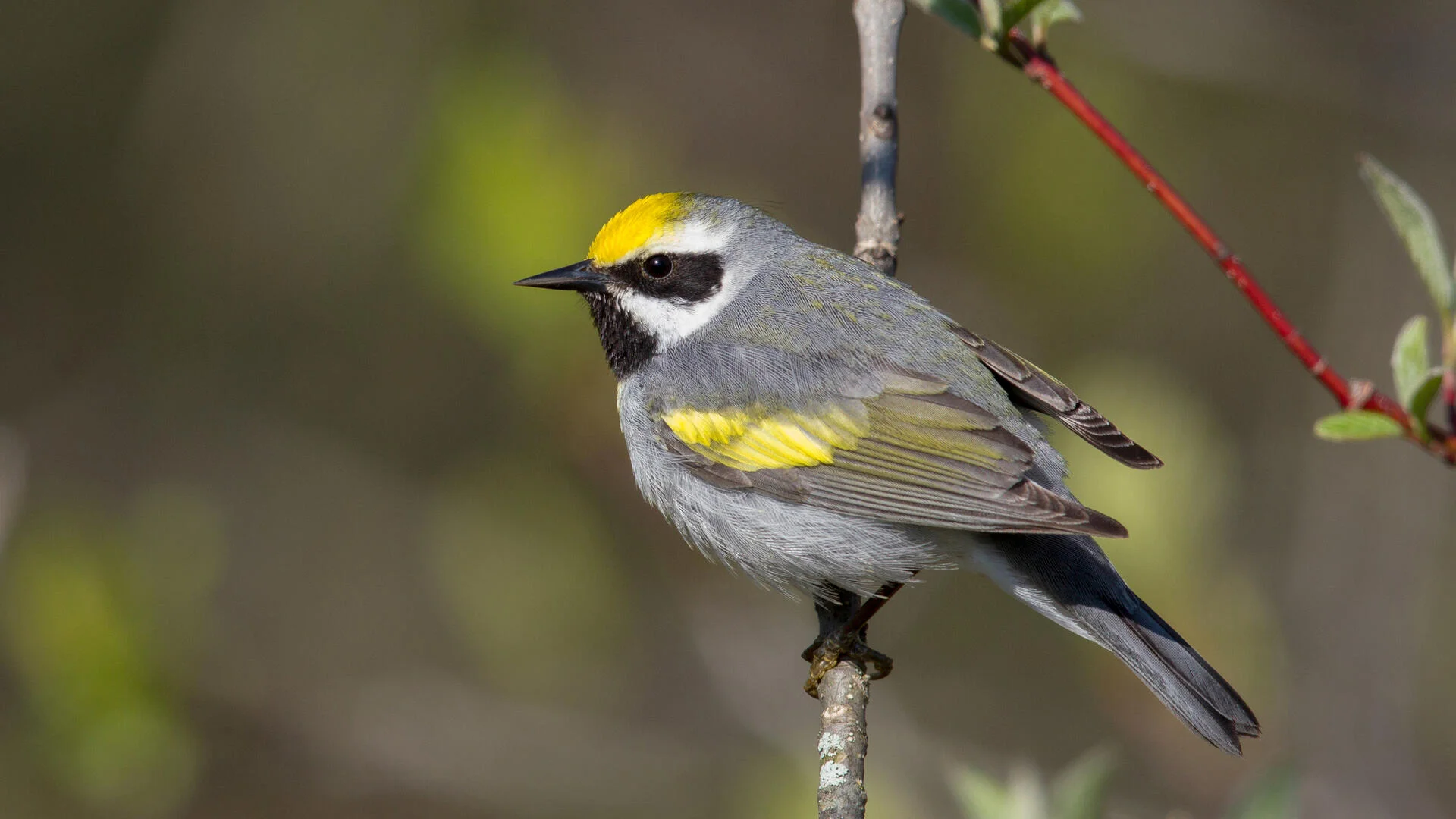This comprehensive handbook provides a valuable resource for identifying the various warbler species that regularly appear in Ohio. With detailed photo identification, descriptions, enchanting melodies captured in audio recordings, and intriguing fun facts, this guide offers much more than just a mere bird-watching companion.
Warblers, these petite migratory songbirds, embark on extraordinary journeys spanning vast distances, from as far as South America to their breeding grounds as distant as Canada. They are vibrant and lively creatures, adorned in splendid shades of yellow and green, serenading their way through the transition from breeding to wintering grounds with a splendid repertoire of captivating songs.
North American warblers, aptly called wood-warblers, predominantly inhabit woodlands and forests. Engaging in the pursuit of spotting these avian gems may even lead to an ailment known as “warbler neck,” characterized by aching stiffness and tingling sensations in the neck resulting from gazing upward with binoculars, scanning the tree canopies for these elusive creatures.
While warblers primarily feed on insects, they occasionally visit backyard feeders, enticed by seeds or mealworms. In addition to identifying the warbler species, this guide also provides information on other bird varieties commonly found in Ohio, along with a printable identification chart, free of charge.
This comprehensive guide not only aids in recognizing the various warbler species found in Ohio but also presents accurate information about their regular occurrences, drawing on data collected by avid birdwatchers through eBird, a renowned online birding platform.
For each warbler featured in this guide, you can immerse yourself in their melodic songs and access a comprehensive compilation of their distinct vocalizations. To enhance your warbler song recognition skills further, consider exploring the companion guide showcasing 13 easily recognizable warbler songs.
Warblers in Ohio exhibit seasonal variations in their presence:
Summer Warblers in Ohio: Yellow Warbler, Common Yellowthroat, American Redstart, Prothonotary Warbler, Yellow-throated Warbler, Hooded Warbler, Blue-winged Warbler, Yellow-breasted Chat, Louisiana Waterthrush, Cerulean Warbler, Prairie Warbler, Kentucky Warbler, Worm-eating Warbler
Winter Warblers in Ohio: Yellow-rumped Warbler
Migration Warblers in Ohio: Palm Warbler, Black-throated Green Warbler, Magnolia Warbler, Northern Parula, Black-and-white Warbler, Nashville Warbler, Chestnut-sided Warbler, Tennessee Warbler, Ovenbird, Blackburnian Warbler, Bay-breasted Warbler, Black-throated Blue Warbler, Blackpoll Warbler, Cape May Warbler, Wilson’s Warbler, Northern Waterthrush, Pine Warbler, Canada Warbler, Mourning Warbler, Orange-crowned Warbler, Golden-winged Warbler, Connecticut Warbler
A grand total of 36 Warbler species grace Ohio’s landscapes:
1. Yellow Warbler
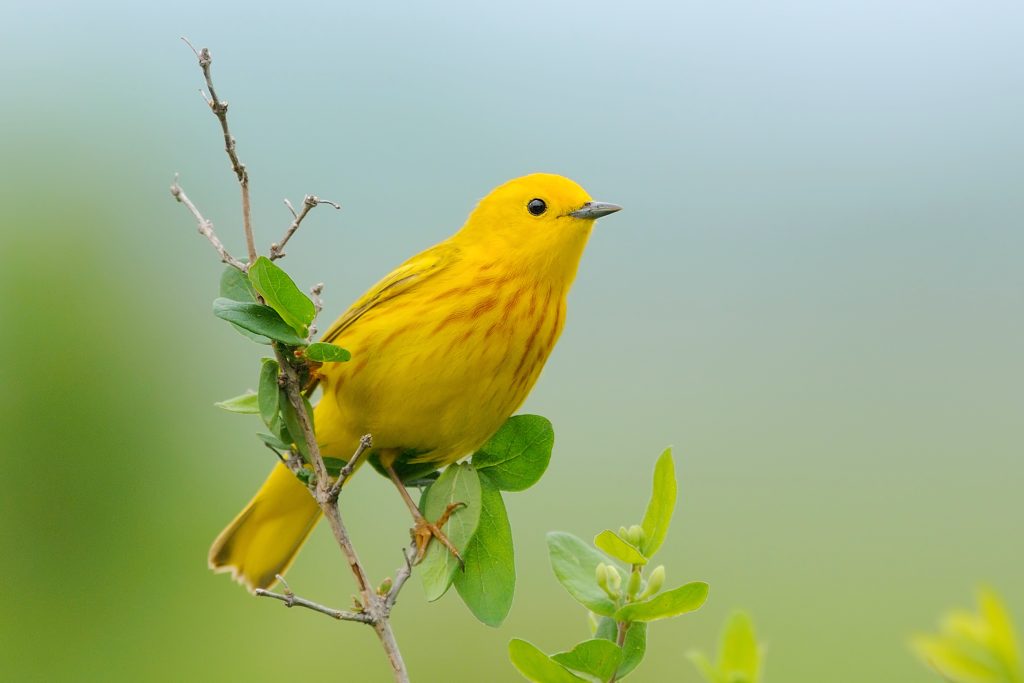
Yellow Warblers, the second most frequently sighted yellow avian species during Ohio’s breeding season, make appearances in approximately 38% of birdwatchers’ summer checklists in the state. These small, vividly yellow birds possess a yellow-green back, with chestnut streaks adorning the breasts of the males. Females and juveniles, while not as radiant as their male counterparts, lack these streaks.
- Scientific Name: Setophaga petechia
- Length: 4.7-5.1 inches (12-13 cm)
- Weight: 0.3-0.4 ounces (9-11 g)
- Wingspan: 6.3-7.9 inches (16-20 cm)
Yellow Warblers undertake long migratory journeys to breed in Canada and the United States, excluding southeastern states, before embarking on their winter sojourn to Central and South America. Nevertheless, glimpses of these captivating birds during migration can be observed in southeastern US states.
Favored habitats for Yellow Warblers include streams, wetlands, thickets, and field edges, where they actively forage for insects such as caterpillars, midges, beetles, bugs, and wasps.
Enjoy the enchanting melodies of the Yellow Warbler:
Credit: Richard E. Webster, XC662546. Accessible at www.xeno-canto.org/662546.
Yellow Warblers construct their nests in small trees or shrubs, skillfully weaving together bark, grass, and plant material, securing them with delicate spider webs to form cup-shaped structures. The nests are further lined with softer materials like hair, feathers, and plant down. In a typical breeding cycle, Yellow Warblers lay up to seven eggs, which hatch after approximately twelve days, and the fledglings leave the nest after an additional ten days.
To attract Yellow Warblers to your backyard, consider providing suet, oranges, peanut butter, and berry-bearing plants. Cultivating native plants that attract insects without resorting to pesticides and maintaining a less pristine environment can also entice these delightful visitors. Additionally, birdbaths equipped with fountains, strategically placed near secluded plantings, offer protection and hydration.
Fun Fact: In a curious turn of events, cowbirds often surreptitiously lay their eggs in the nests of Yellow Warblers. Once discovered, the vigilant Yellow Warblers respond by constructing a fresh nest on top of the old one, effectively discarding the intruding eggs. This remarkable behavior can be repeated up to six times!
2. Common Yellowthroat
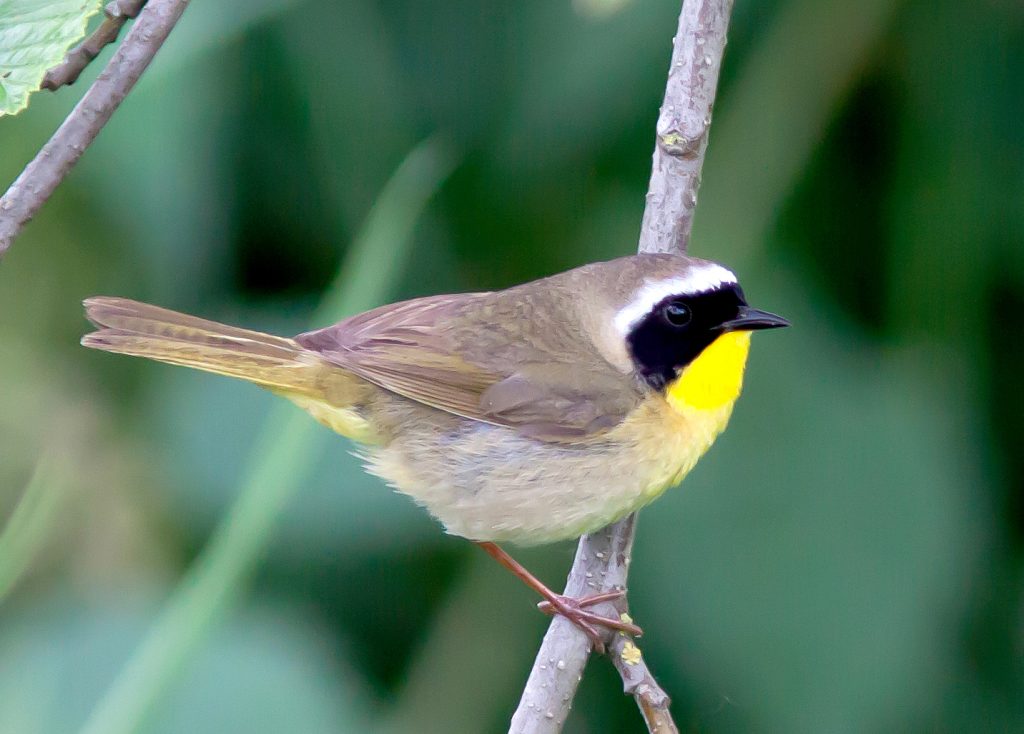
Common Yellowthroats frequently grace Ohio’s landscapes during the breeding season. Their appearances are most notable between April and October, accounting for around 31% of summer checklists.
These diminutive songbirds exhibit brownish plumage on their backs, contrasted by a vibrant yellow underbelly and long tails. Males possess black masks that encompass their faces. Geographical variations may result in differing shades of yellow, occasionally appearing more olive-toned on certain portions of their bodies.
- Scientific Name: Geothlypis trichas
- Length: 4.3-5.1 inches (11-13 cm)
- Weight: 0.3-0.3 ounces (9-10 g)
- Wingspan: 5.9-7.5 inches (15-19 cm)
Common Yellowthroats embark on a summer-long breeding journey across most of North America, except for Alaska and northern Canada. Some individuals choose to remain in the vicinity of the Gulf Coast and the Pacific Southwest throughout the year, while others undertake southward migrations for winter.
These charming birds frequently inhabit marshy areas, wetlands, and brushy fields, favoring thick, tangled vegetation as their dwellings.
Indulge in the melodious chorus of the Common Yellowthroat:
Credit: Paul Marvin, XC629250. Accessible at www.xeno-canto.org/629250.
Nests of the Common Yellowthroat are skillfully crafted by females, strategically positioned near the ground in marshy regions and supported by sturdy reeds. The nests are constructed using a combination of grass, sedges, and leaves, forming a platform that supports the structure. Up to six eggs are laid, requiring roughly twelve days for incubation and an additional period of time for the young ones to fledge.
To attract these delightful birds to larger backyards, dense vegetation and native plants play a vital role in creating an insect-rich environment.
Fun Fact: The black mask adorning the faces of male Common Yellowthroats serves as a visual cue for other males during courtship rituals. When encountering artificial decoys lacking this characteristic feature, these vigilant birds fiercely attack. However, when presented with maskless decoys, they remain unprovoked.
3. Yellow-rumped Warbler
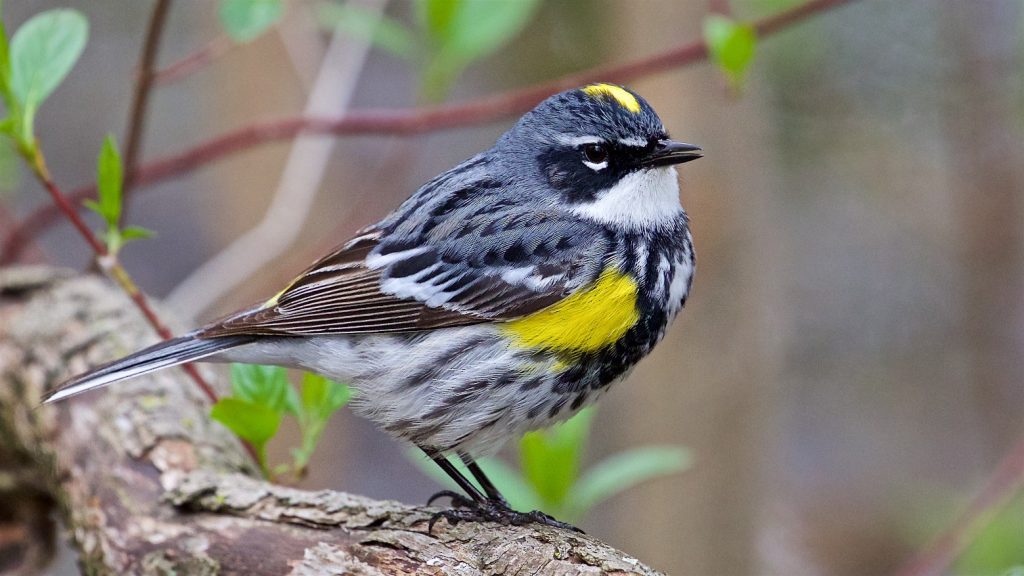
Yellow-rumped Warblers can be observed in Ohio during the winter season, with their numbers surging during migration in April to May and September to November. They are recorded in 2% of winter checklists and up to 39% during migration.
These warblers exhibit gray plumage with flashes of yellow on their face, sides, and rump, along with white accents on their wings. Female individuals may appear slightly brown, while winter birds showcase paler brown tones, with their bright yellow rumps and sides transitioning back to yellow and gray as spring arrives.
- Scientific Name: Setophaga coronata
- Length: 4.7-5.5 inches (12-14 cm)
- Weight: 0.4-0.5 ounces (12-13 g)
- Wingspan: 7.5-9.1 inches (19-23 cm)
Yellow-rumped Warblers primarily breed in Canada, as well as parts of the Rockies and the Appalachian mountains. During migration, they traverse the Midwest before wintering in southern and southwestern U.S. states, along the Pacific Coast, Mexico, and Central America.
These warblers can be found in coniferous forests, particularly during the breeding season. In winter, they frequent open areas with fruiting shrubs. Their diet consists mainly of insects during summer and migration, shifting towards a fruit-based diet, including bayberry and wax myrtle, during winter.
Immerse yourself in the melodious tune of the Yellow-rumped Warbler:
Credit: Christopher McPherson, XC602699. Accessible at www.xeno-canto.org/602699.
Nests of Yellow-rumped Warblers, crafted by females, can be found in conifer trees, constructed using twigs, pine needles, and grass. These nests are lined with soft grass, moss, and hair. The average clutch size is six eggs, which hatch in approximately two weeks, followed by another two weeks before the young fledge.
To attract Yellow-rumped Warblers to your backyard, consider offering sunflower seeds, suet, raisins, and peanut butter.
Fun Fact: During winter, Yellow-rumped Warblers form flocks numbering in the thousands, and they can be quite assertive when it comes to warding off other bird species from their territory.
4. American Redstart
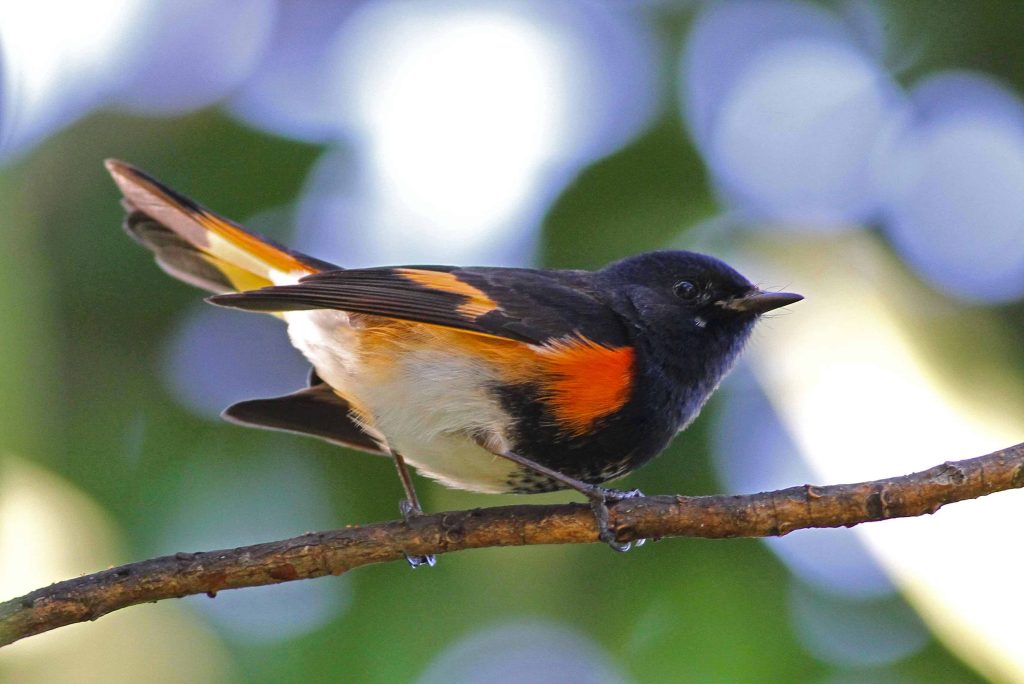
American Redstarts primarily spend the breeding season in Ohio, but they are more commonly sighted during migration in May and September. They appear in 14% of summer checklists and up to 33% during migration.
These striking birds feature predominantly black plumage with vibrant orange patches and a white belly. Female American Redstarts exhibit an olive-gray coloration instead of black, adorned with yellow patches.
- Scientific Name: Setophaga ruticilla
- Length: 4.3-5.1 inches (11-13 cm)
- Weight: 0.2-0.3 ounces (6-9 g)
- Wingspan: 6.3-7.5 inches (16-19 cm)
American Redstarts breed in eastern U.S. states, Canada, and extend to northwestern U.S. states. They can also be sighted during migration in central and western U.S. states.
These delightful warblers can be found in deciduous woodlands, where they feed on insects. Additionally, they visit backyards and thickets to enjoy berries such as serviceberry and magnolia.
Listen to the captivating melody of the American Redstart:
Credit: Nick Kiehl, XC522368. Accessible at www.xeno-canto.org/522368.
Nests of American Redstarts are situated close to the trunk of trees or large shrubs, constructed using bark, grass, and other plant materials. They lay up to five eggs, which hatch in just under two weeks, and the young ones leave the nest after another week or two.
To attract American Redstarts to your backyard, consider planting berry-producing plants like magnolia and serviceberry.
Fun Fact: When it comes to parental duties, male American Redstarts focus primarily on singing and removing fecal sacs, while the rearing of young, including incubation and feeding, is predominantly carried out by the females.
5. Palm Warbler
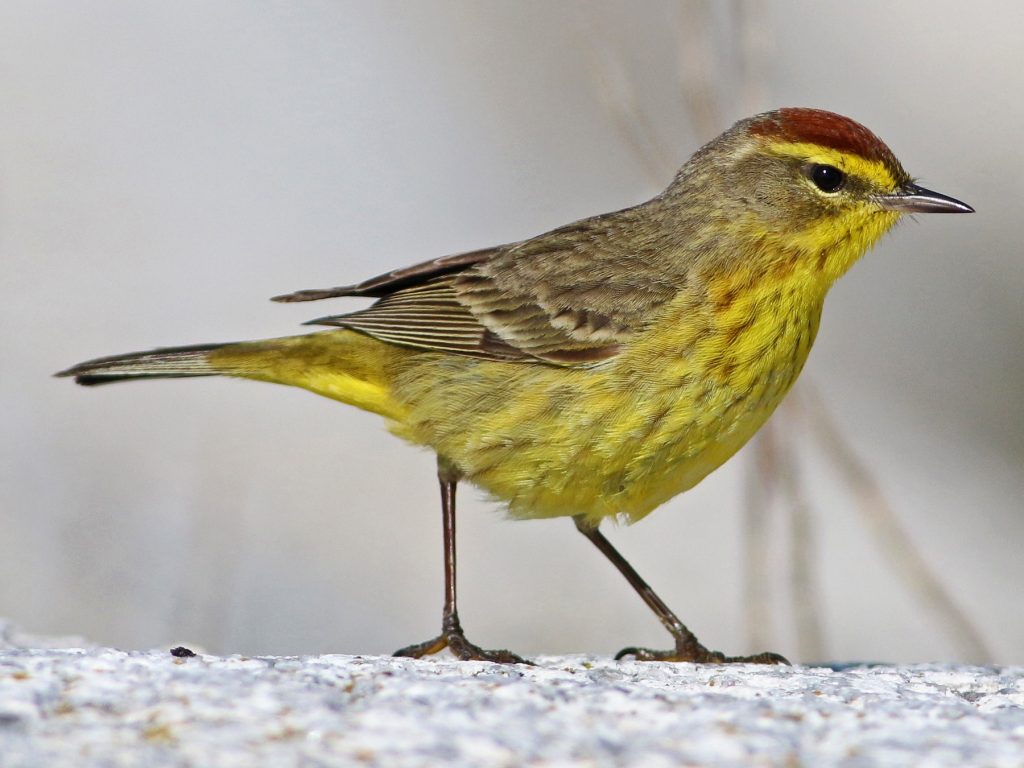
Palm Warblers can be spotted in Ohio during migration from April to May and September to October, with their peak occurrence during the spring migration in May, accounting for 29% of checklists at that time.
These warblers feature a rusty red patch on the crown of their heads and a browny-olive coloration on the rest of their bodies. Western individuals tend to have whiter bellies. Male and female Palm Warblers exhibit no distinguishable differences during the breeding season, while non-breeding birds display duller crowns.
- Scientific Name: Setophaga palmarum
- Length: 4.7-5.5 inches (12-14 cm)
- Weight: 0.3-0.5 ounces (7-13 g)
- Wingspan: 7.9-8.3 inches (20-21 cm)
Palm Warblers primarily breed in Canada, and during migration, they can be observed in eastern U.S. states. Some individuals choose to spend their winters in Florida, along the southeastern coast, while others migrate to Mexico and Central America.
You can spot Palm Warblers mainly during spring and fall migrations in weedy fields, forest edges, and scrubby areas. They are often seen foraging on the ground for insects, mingling with other bird species like Sparrows, Juncos, and Yellow-rumped Warblers.
Delight in the melodious tune of the Palm Warbler:
Credit: Richard E. Webster, XC189604. Accessible at www.xeno-canto.org/189604.
Nests of Palm Warblers are located in bogs and boreal forests, situated on the ground. These nests are crafted using grass, sedge, and ferns woven together into a cup shape, further lined with soft grass, feathers, and animal hair. The average clutch size is around five eggs.
To attract Palm Warblers to your backyard, consider planting native plants that attract insects, alongside bayberry or hawthorn to provide a source of berries.
Fun Fact: Unlike many other warblers, Palm Warblers have a distinct behavior of walking on the ground, accompanied by bobbing their tails while foraging for insects.
6. Black-throated Green Warbler

Black-throated Green Warblers are primarily observed in Ohio during the spring and fall migrations, but a few individuals also spend the breeding season in the southern part of the state.
These warblers showcase a combination of small yellow bodies, yellow faces and heads, and olive-yellow backs. They exhibit black streaking on the sides and wings, with a whitish underbelly. Male individuals possess larger black patches on their throats, while females and juveniles feature smaller patches.
- Scientific Name: Setophaga virens
- Length: 4.3-4.7 inches (11-12 cm)
- Weight: 0.3-0.4 ounces (7-11 g)
- Wingspan: 6.7-7.9 inches (17-20 cm)
Black-throated Green Warblers embark on extensive migrations, flying across the eastern United States up to their breeding grounds in northeastern
U.S. states and Canada. During winter, they can be found in Mexico, northern South America, and the Caribbean.
These warblers primarily inhabit the upper parts of forests, feeding on insects. Their black throat serves as a distinguishing feature, aiding in their differentiation from other small yellow birds.
Enjoy the captivating song of the Black-throated Green Warbler:
Credit: Paul Driver, XC187636. Accessible at www.xeno-canto.org/187636.
Nests of Black-throated Green Warblers are situated in small trees, close to the trunk. They are constructed using twigs, bark, and spiders’ webs, woven together and lined with animal hair, moss, and feathers. The average clutch size is approximately four eggs, with an incubation period of twelve days, followed by another ten days before the young fledge.
To attract Black-throated Green Warblers to your backyard, mature trees play a vital role.
Fun Fact: Male Black-throated Green Warblers can sing over 400 times in an hour and engage in a distinctive “gloating” flight to assert dominance after chasing off rivals.
7. Magnolia Warbler
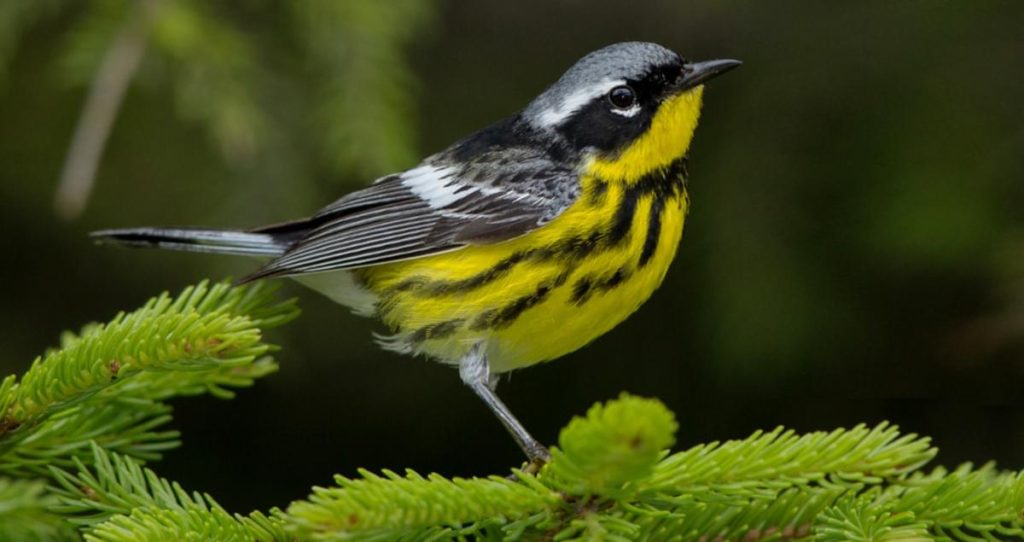
Magnolia Warblers are primarily sighted in Ohio during the spring and fall migrations, occurring in May and from August to October.
These warblers exhibit predominantly yellow bodies with a green back and a gray head, accompanied by a white eye-ring. Female and juvenile Magnolia Warblers are paler than their male counterparts. They possess a distinct white belly nestled between their yellow breasts and under their tails.
- Scientific Name: Setophaga magnolia
- Length: 4.3-5.1 inches (11-13 cm)
- Weight: 0.2-0.5 ounces (6-15 g)
- Wingspan: 6.3-7.9 inches (16-20 cm)
Magnolia Warblers breed across Canada and northeastern U.S. states. During migration, they can be spotted in the eastern United States. They spend their winters in Central America and the Caribbean.
These captivating warblers can be found perched on low branches in forests or parks, making them more easily visible during migration. They primarily feed on insects and spiders.
Listen to the melodious song of the Magnolia Warbler:
Credit: Peter Ward and Ken Hall, XC512264. Accessible at www.xeno-canto.org/512264.
Nests of Magnolia Warblers are loosely constructed with grass and weeds, positioned near the trunk of conifer trees. They lay around four eggs, with an incubation period of twelve days, followed by approximately nine days for the young ones to leave the nest.
To attract Magnolia Warblers to your backyard during migration, consider incorporating native shrubs and trees, particularly those that produce berries.
Fun Fact: Magnolia Warblers adeptly display the white spots on their tails during courtship to attract females and ward off rivals.
8. Northern Parula
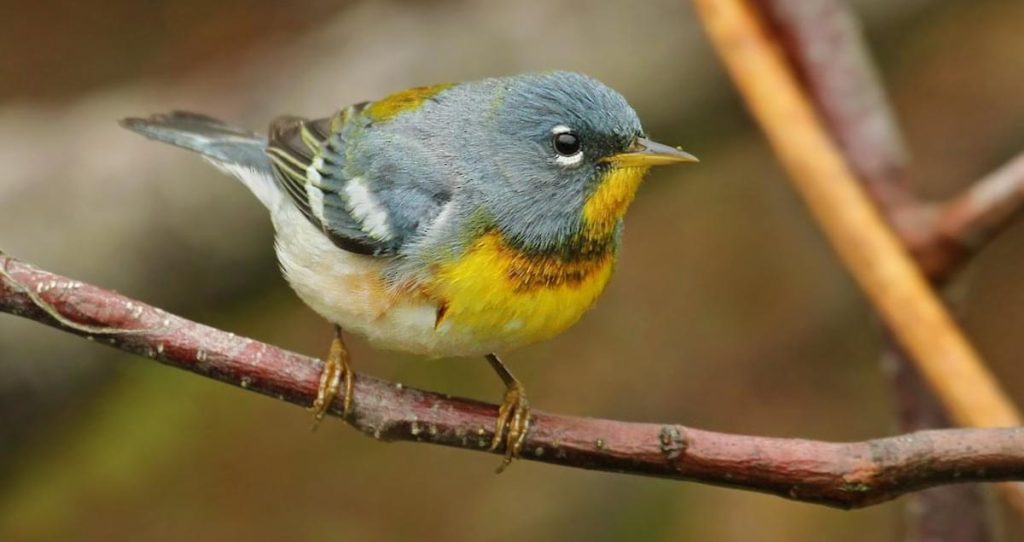
Northern Parulas are predominantly observed during migration in northern Ohio, but they also spend the breeding season in the southern part of the state. They appear in 10% of summer checklists and up to 20% during the spring migration.
These warblers exhibit a captivating blend of blueish-gray and yellow plumage. They showcase bluish-gray backs with a yellow patch on their backs and two white wingbars.
Male Northern Parulas possess a chestnut band that separates their yellow throat and chest, a characteristic also found in females. However, females are paler overall compared to their male counterparts. Juveniles share a similar appearance to females.
- Scientific Name: Setophaga americana
- Length: 4.3-4.7 inches (11-12 cm)
- Weight: 0.2-0.4ounces (5-11 g)
- Wingspan: 6.3-7.1 inches (16-18 cm)
Northern Parulas breed in eastern U.S. states, southeastern Canada, and migrate to Central America and the Caribbean for winter. Some individuals remain in southern Florida during the winter season.
These delightful warblers can be found foraging on insects high up in deciduous forests.
Listen to the enchanting song of the Northern Parula:
Credit: Christopher McPherson, XC599828. Accessible at www.xeno-canto.org/599828.
Nests of Northern Parulas are created using long clumps of lichen and moss, forming an exquisite drape from the branches. To spot them, look for large clumps of hanging moss during the summer months.
To attract Northern Parulas to your backyard, incorporate native trees and shrubs, especially those with berries. Additionally, leaving brush piles creates a conducive environment for insects, their primary food source.
Fun Fact: Northern Parula females are responsible for incubating the eggs and feeding the young ones, while the males focus on singing and removing fecal sacs.
9. Black-and-white Warbler
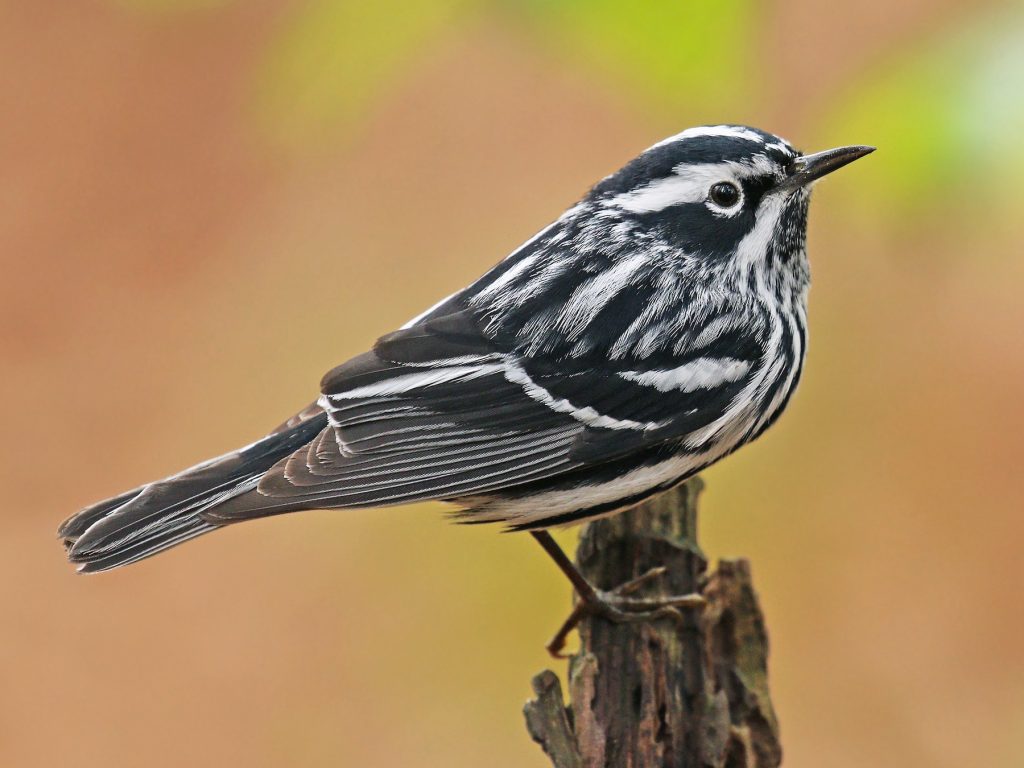
Black-and-white Warblers can be found in Ohio during migration, appearing in up to 19% of checklists during these periods. However, some individuals also spend the breeding season in the southern part of the state.
These warblers boast a distinct striped appearance, making them easily recognizable. Male Black-and-white Warblers possess a large black patch across their eye and cheek, exhibiting a darker black coloration than females.
- Scientific Name: Mniotilta varia
- Length: 4.3-5.1 inches (11-13 cm)
- Weight: 0.3-0.5 ounces (8-15 g)
- Wingspan: 7.1-8.7 inches (18-22 cm)
Black-and-white Warblers breed in eastern United States and Canada, while spending winters in Florida, along the Gulf Coast, Mexico, Baja California, the Caribbean, and northern South America. They can be observed during migration in central U.S. states.
These warblers can be spotted as they skillfully navigate tree trunks and branches, moving up and down in search of insects.
Listen to the delightful song of the Black-and-white Warbler:
Credit: Christopher McPherson, XC600300. Accessible at www.xeno-canto.org/600300.
Nests of Black-and-white Warblers are concealed close to or on the ground, often under logs or shrubs. Constructed using bark, grass, and pine needles woven into a cup shape, these nests provide a safe haven for their approximately five eggs. The incubation period lasts around eleven days, with an additional ten days for the young ones to leave the nest.
10. Nashville Warbler
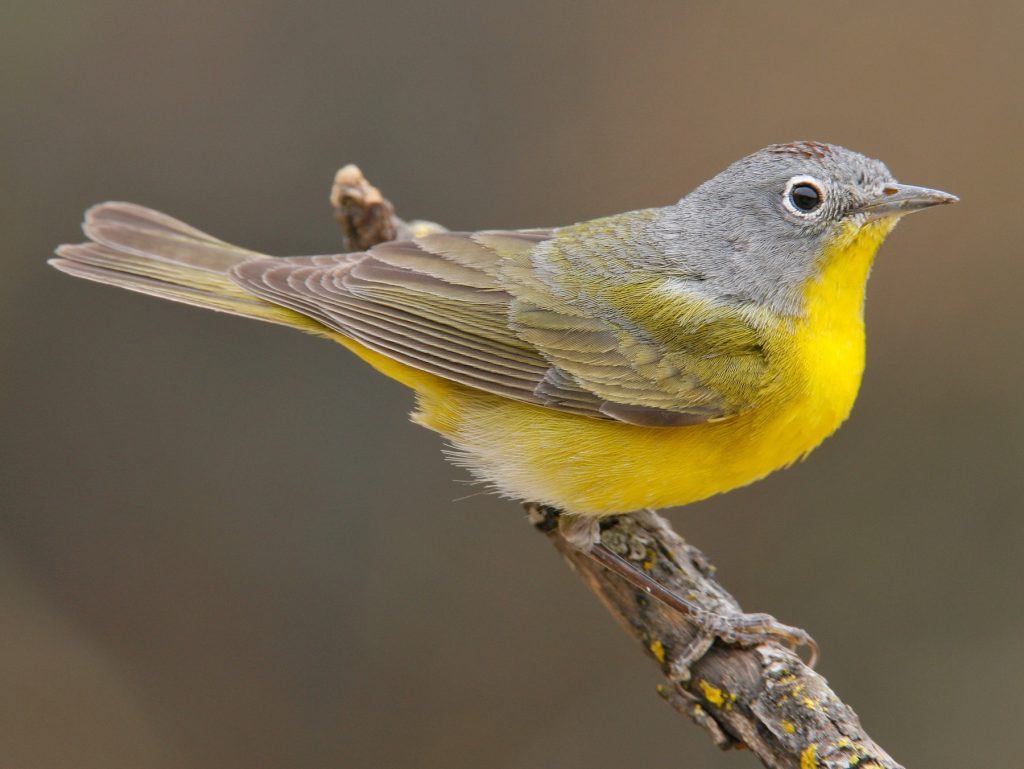
Nashville Warblers are primarily spotted in Ohio during the spring and fall migrations, occurring from April to May and again from September to October.
These warblers exhibit mostly yellow plumage with a green back and a gray head adorned with a white eye-ring. Females and juveniles are not as vibrant as males, displaying a paler appearance. They possess distinct white bellies between their yellow breasts and under their tails.
- Scientific Name: Leiothlypis ruficapilla
- Length: 4.3-5.1 inches (11-13 cm)
- Weight: 0.2-0.5 ounces (6.7-13.9 g)
- Wingspan: 6.7-7.9 inches (17-20 cm)
Nashville Warblers breed in northeastern U.S. states and Canada, with a smaller population found in northwestern U.S. states and British Columbia. They can also be sighted during migration across most states.
These delightful warblers can be found in scrubby habitats and low deciduous forests, where they actively hunt for insects.
Listen to the charming song of the Nashville Warbler:
Credit: Peter Ward and Ken Hall, XC512262. Accessible at www.xeno-canto.org/512262.
Nests of Nashville Warblers are situated close to the ground and are constructed using bark, moss, and grass woven into a cup-like structure. The nests are lined with pine needles, soft grass, and animal hair. They typically lay around five eggs, with an incubation period of twelve days, followed by an additional ten days for the young ones to leave the nest.
To attract Nashville Warblers to your backyard during winter or in southern U.S. states, consider providing suet as a food source.
Fun Fact: Nashville Warblers initially migrate along the Atlantic Coast, but subsequent migrations always occur inland.
11. Chestnut-sided Warbler
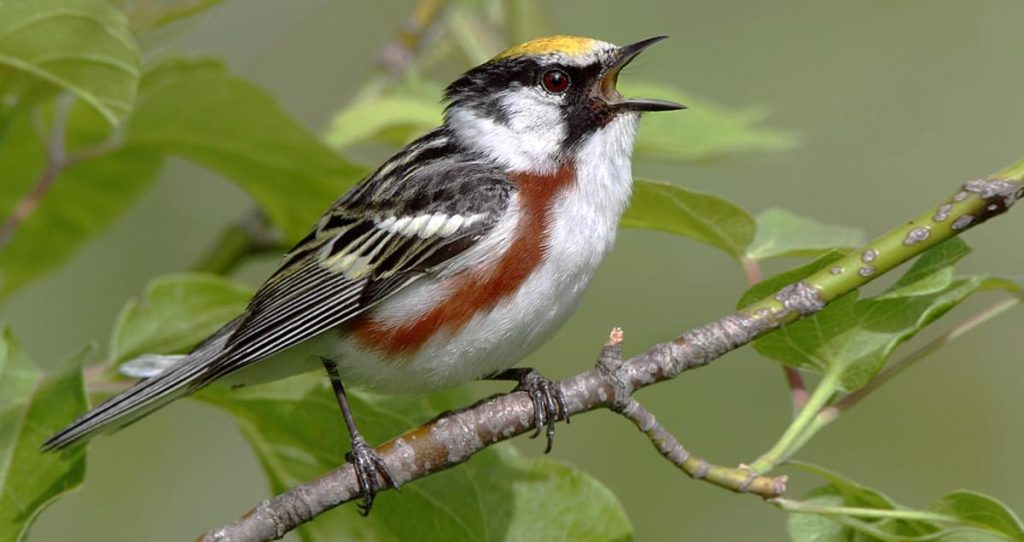
Chestnut-sided Warblers can be observed in Ohio during the spring and fall migrations, making appearances from April to May and again from August to September.
These warblers exhibit a striking color combination of yellow, green, and chestnut. They have yellow underparts with chestnut streaks on their sides and a white breast. Males showcase vibrant chestnut patches on their sides and crowns, while females have paler markings.
- Scientific Name: Setophaga pensylvanica
- Length: 4.3-4.7 inches (11-12 cm)
- Weight: 0.3-0.4 ounces (8-11 g)
- Wingspan: 6.7-7.5 inches (17-19 cm)
Chestnut-sided Warblers breed in northeastern U.S. states and parts of Canada. During migration, they can be sighted in eastern U.S. states and occasionally in the Midwest.
These lively warblers inhabit young deciduous forests, woodland edges, and shrubby areas, where they actively search for insects.
Enjoy the melodious song of the Chestnut-sided Warbler:
Credit: James Bradley, XC425702. Accessible at www.xeno-canto.org/425702.
Nests of Chestnut-sided Warblers are constructed in shrubs or saplings close to the ground. They are made from twigs, leaves, bark, and other plant materials, woven together to form a cup. These warblers lay a clutch of around four to five eggs, which hatch after approximately twelve days. The young ones remain in the nest for about ten days before venturing out.
To attract Chestnut-sided Warblers to your backyard, provide a mix of mature trees and shrubby areas.
Fun Fact: Male Chestnut-sided Warblers engage in a unique display called the “flutter glide,” where they glide with spread wings and rapidly flutter them, creating a visual spectacle during courtship.
12. Tennessee Warbler
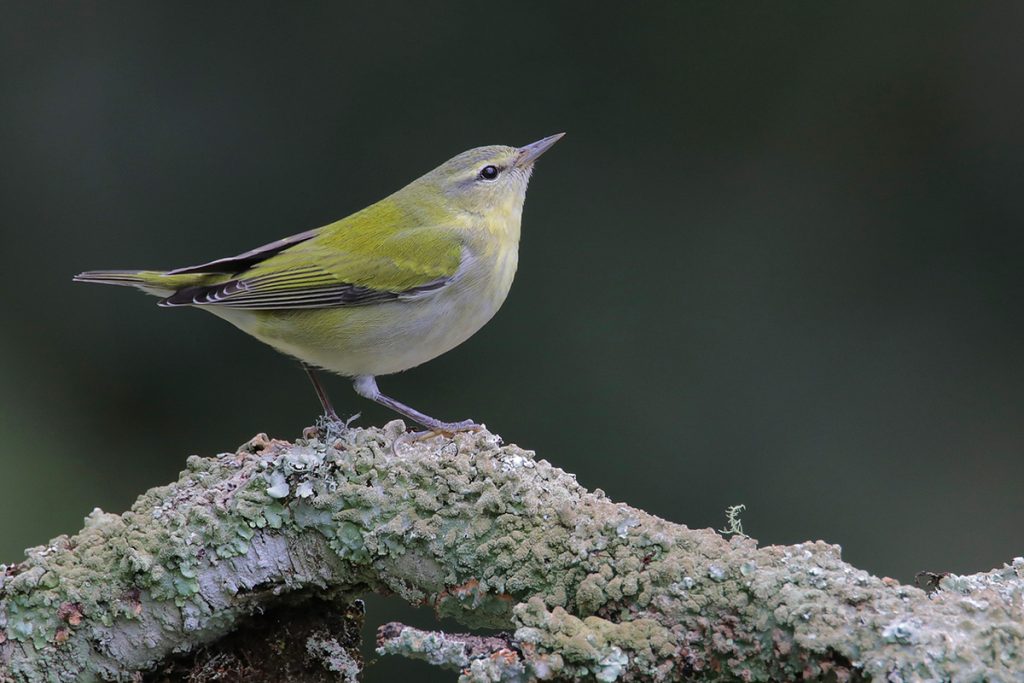
Tennessee Warblers can be spotted in Ohio during the spring and fall migrations, appearing from April to May and again from August to September.
These warblers exhibit predominantly olive-green plumage with a white belly and a faint grayish head. They possess a distinct white eye-ring and undertail coverts. Males and females share a similar appearance.
- Scientific Name: Leiothlypis peregrina
- Length: 4.3-4.7 inches (11-12 cm)
- Weight: 0.3-0.4 ounces (7-11 g)
- Wingspan: 6.7-7.5 inches (17-19 cm)
Tennessee Warblers breed in the boreal forests of Canada and Alaska. During migration, they can be observed in eastern U.S. states.
These warblers prefer to forage for insects high in the canopy of coniferous trees, where they display agile flight patterns.
Listen to the sweet song of the Tennessee Warbler:
Credit: Andrew Spencer, XC425630. Accessible at www.xeno-canto.org/425630.
Nests of Tennessee Warblers are typically constructed on the ground, often tucked away under low vegetation. They are made from grasses, leaves, and moss, skillfully woven together to form a cup-like structure. These warblers lay a clutch of around four to five eggs, which hatch after an incubation period of approximately twelve days. The young ones remain in the nest for another ten days before taking flight.
To attract Tennessee Warblers to your backyard during migration, provide suitable habitat with dense vegetation and a variety of insects.
Fun Fact: Tennessee Warblers were named after the state of Tennessee, where the first specimen was collected. However, they do not breed in Tennessee.
13. Ovenbird

Ovenbirds can be found in Ohio during the spring and fall migrations, making appearances from April to May and again from August to September.
These warblers are known for their distinct appearance, featuring a rusty-brown crown with bold black stripes and olive-brown upperparts. Their underparts are pale, with dark streaking on the breast. Males and females share a similar appearance.
- Scientific Name: Seiurus aurocapilla
- Length: 5.1-5.9 inches (13-15 cm)
- Weight: 0.6-0.7 ounces (18-20 g)
- Wingspan: 7.9-8.3 inches (20-21 cm)
Ovenbirds breed across eastern U.S. states, southern Canada, and parts of the Great Lakes region. They can be observed during migration across most of the United States.
These ground-dwelling warblers inhabit deciduous forests, where they forage for insects and construct their unique oven-shaped nests on the forest floor.
Listen to the beautiful song of the Ovenbird:
Credit: Jonathon Jongsma, XC606041. Accessible at www.xeno-canto.org/606041.
Nests of Ovenbirds are intricately woven structures made from leaves, grass, and bark, forming an enclosed dome with a side entrance, resembling an old-fashioned oven. They lay a clutch of approximately three to six eggs, which hatch after an incubation period of about twelve to fourteen days. The young ones leave the nest after another eight to eleven days.
To attract Ovenbirds to your backyard during migration, maintain a natural, undisturbed environment with dense vegetation.
Fun Fact: Ovenbirds possess one of the most distinctive songs among North American birds. Their song consists of a loud, ringing “teacher, teacher, teacher!” phrase, often repeated.
14. Blackburnian Warbler
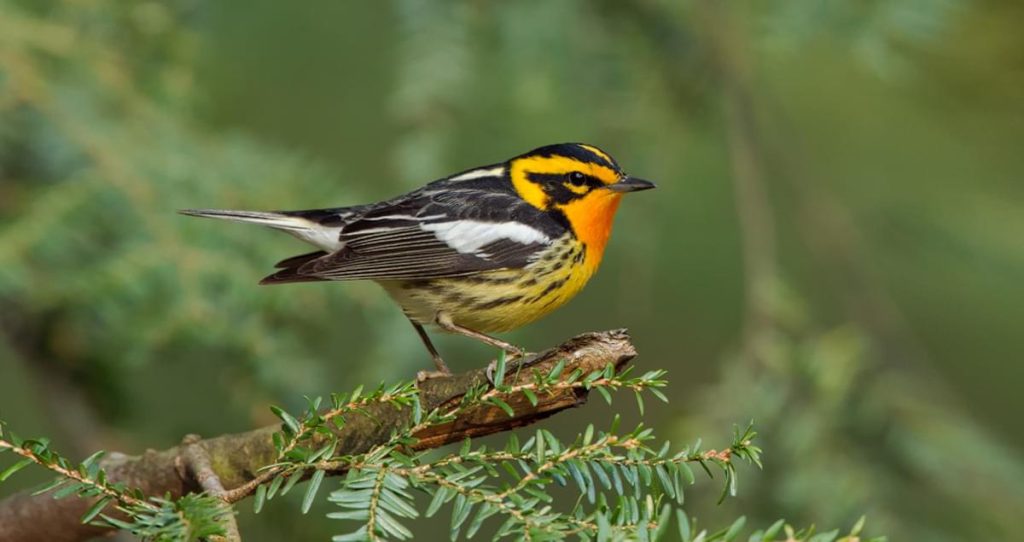
Blackburnian Warblers can be observed in Ohio during the spring and fall migrations, appearing from April to May and again from August to September.
These warblers showcase vibrant orange throats and bold black-and-white patterns. Males possess a striking black crown, while females have a more subdued appearance.
- Scientific Name: Setophaga fusca
- Length: 4.3-4.7 inches (11-12 cm)
- Weight: 0.3-0.4 ounces (7-11 g)
- Wingspan: 7.1-7.9 inches (18-20 cm)
Blackburnian Warblers breed in the boreal forests of Canada and the northeastern United States. During migration, they can be sighted in eastern and central U.S. states.
These canopy-dwelling warblers primarily feed on insects, often catching them while in flight.
Listen to the distinctive song of the Blackburnian Warbler:
Credit: Eric DeFonso, XC426505. Accessible at www.xeno-canto.org/426505.
Nests of Blackburnian Warblers are constructed high in the canopy of coniferous trees. They are built using twigs, moss, lichens, and spider silk, creating a sturdy cup-like structure. These warblers lay a clutch of around three to five eggs, which hatch after an incubation period of approximately two weeks. The young ones remain in the nest for another nine to ten days before fledging.
To attract Blackburnian Warblers to your backyard during migration, provide tall trees with ample foliage and a diverse insect population.
Fun Fact: Blackburnian Warblers have a unique foraging behavior known as “hover-gleaning,” where they hover in mid-air to pluck insects from leaves and branches.
15. Bay-breasted Warbler
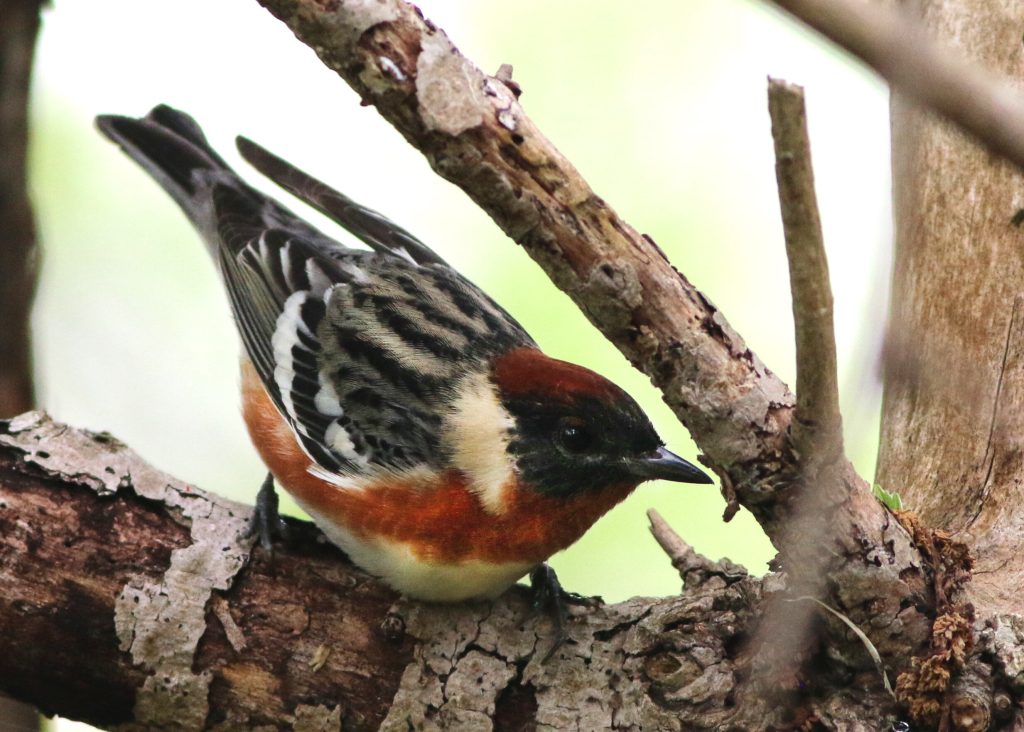
Bay-breasted Warblers are primarily spotted in Ohio during the spring and fall migrations, appearing from April to May and again from August to September.
These warblers exhibit a striking plumage featuring rich chestnut-colored crowns and underparts. Males possess a more vibrant appearance, while females showcase paler tones.
- Scientific Name: Setophaga castanea
- Length: 4.7-5.1 inches (12-13 cm)
- Weight: 0.3-0.4 ounces (8-11 g)
- Wingspan: 7.5-8.3 inches (19-21 cm)
Bay-breasted Warblers breed in the boreal forests of Canada and parts of the northeastern United States. During migration, they can be observed in eastern and central U.S. states.
These active warblers primarily forage for insects high in the canopy of coniferous and mixed forests.
Listen to the melodious song of the Bay-breasted Warbler:
Credit: Nick Block, XC598760. Accessible at www.xeno-canto.org/598760.
Nests of Bay-breasted Warblers are typically constructed on horizontal branches of coniferous trees. They are made from twigs, lichens, and plant fibers, forming a neat cup-shaped structure. These warblers lay a clutch of approximately three to five eggs, which hatch after an incubation period of about twelve days. The young ones remain in the nest for another ten to twelve days before taking flight.
To attract Bay-breasted Warblers to your backyard during migration, provide a mix of coniferous and deciduous trees with an abundance of insects.
Fun Fact: Bay-breasted Warblers undergo a molt after the breeding season, changing their vibrant breeding plumage to a more subdued appearance for their wintering grounds.
16. Black-throated Blue Warbler
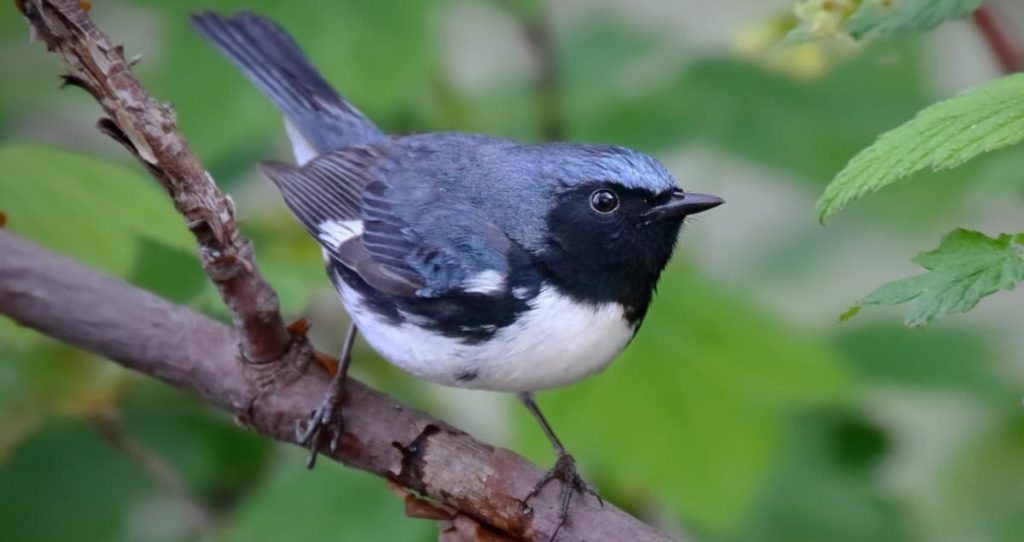
Black-throated Blue Warblers can be found in Ohio during the spring and fall migrations, appearing from April to May and again from August to September.
These warblers exhibit striking sexual dimorphism. Male Black-throated Blue Warblers possess deep blue upperparts and a bold black throat, while females showcase a more subtle appearance with grayish-olive upperparts and a white throat.
- Scientific Name: Setophaga caerulescens
- Length: 4.7-5.1 inches (12-13 cm)
- Weight: 0.3-0.4 ounces (9-11 g)
- Wingspan: 7.5-8.3 inches (19-21 cm)
Black-throated Blue Warblers breed in the northeastern United States and parts of Canada. During migration, they can be observed in eastern U.S. states.
These warblers prefer to forage in the understory of deciduous and mixed forests, where they actively search for insects.
Listen to the delightful song of the Black-throated Blue Warbler:
Credit: Eric DeFonso, XC426246. Accessible at www.xeno-canto.org/426246.
Nests of Black-throated Blue Warblers are typically located in shrubs or small trees, often in the vicinity of streams. They are constructed using twigs, grass, bark, and other plant materials, forming a neat cup-shaped structure. These warblers lay a clutch of approximately three to four eggs, which hatch after an incubation period of about twelve days. The young ones remain in the nest for another ten to twelve days before fledging.
To attract Black-throated Blue Warblers to your backyard during migration, provide a diverse habitat with understory vegetation and a variety of insects.
Fun Fact: Male Black-throated Blue Warblers play a significant role in parental care, assisting in feeding the young ones and defending the nest from predators.
17. Blackpoll Warbler

Blackpoll Warblers can be spotted in Ohio during the spring and fall migrations, appearing from April to May and again from September to October.
These warblers display a subtle appearance with grayish-black crowns and white underparts. Their legs and feet are often yellow, providing a distinct feature for identification.
- Scientific Name: Setophaga striata
- Length: 4.7-5.1 inches (12-13 cm)
- Weight: 0.3-0.4 ounces (9-11 g)
- Wingspan: 8.3-9.1 inches (21-23 cm)
Blackpoll Warblers breed in the boreal forests of Canada and Alaska. During migration, they can be observed across most of the United States.
These remarkable long-distance migrants undertake an incredible journey, flying nonstop for thousands of miles over the Atlantic Ocean to reach their wintering grounds in South America.
Listen to the unique song of the Blackpoll Warbler:
Credit: Andrew Spencer, XC426591. Accessible at www.xeno-canto.org/426591.
Nests of Blackpoll Warblers are constructed on the ground, typically in mossy areas or the base of shrubs. They are made from grass, leaves, and other plant materials, forming a well-hidden cup-shaped structure. These warblers lay a clutch of approximately four to five eggs, which hatch after an incubation period of about twelve to thirteen days. The young ones remain in the nest for another nine to eleven days before fledging.
To attract Blackpoll Warblers to your backyard during migration, provide suitable habitat with a mix of trees and shrubs for cover and a variety of insects.
Fun Fact: Blackpoll Warblers undergo a remarkable transformation before embarking on their long migration, changing their appearance from a black-capped bird to a nearly completely white-capped bird.
18. Cape May Warbler
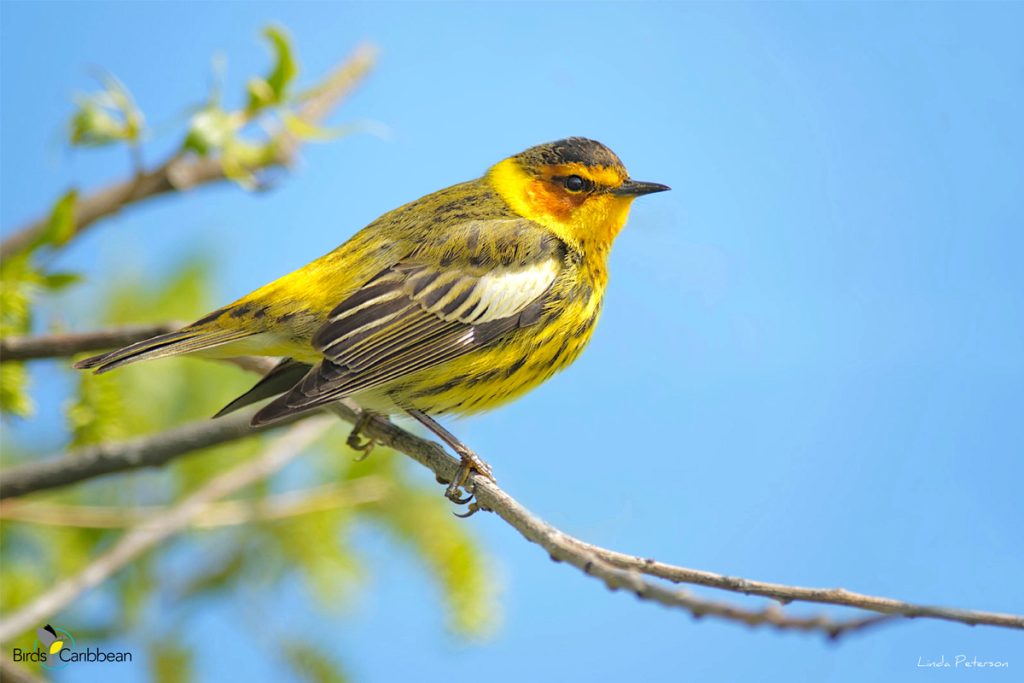
Cape May Warblers can be found in Ohio during the spring and fall migrations, appearing from April to May and again from August to September.
These warblers showcase a unique and distinctive appearance. Their plumage features a mix of olive-green, yellow, and chestnut tones, with a bold rusty cheek patch.
- Scientific Name: Setophaga tigrina
- Length: 4.7-5.1 inches (12-13 cm)
- Weight: 0.3-0.4 ounces (9-11 g)
- Wingspan: 7.5-8.3 inches (19-21 cm)
Cape May Warblers breed in the boreal forests of Canada and Alaska. During migration, they can be observed across most of the eastern and central United States.
These warblers primarily forage for insects, often using their specialized tubular tongue to extract nectar from flowers.
Listen to the unique song of the Cape May Warbler:
Credit: Paul Marvin, XC622057. Accessible at www.xeno-canto.org/622057.
Nests of Cape May Warblers are typically located in coniferous trees, often high up near the tip of branches. They are constructed using twigs, grasses, moss, and lichens, forming a sturdy cup-shaped structure. These warblers lay a clutch of approximately three to five eggs, which hatch after an incubation period of about twelve to thirteen days. The young ones remain in the nest for another nine to ten days before taking flight.
To attract Cape May Warblers to your backyard during migration, provide a mix of coniferous and deciduous trees, as well as flowering plants to offer nectar sources.
Fun Fact: The unique rusty cheek patch of the Cape May Warbler is actually caused by a special type of modified feather, not pigmentation.
19. Wilson’s Warbler
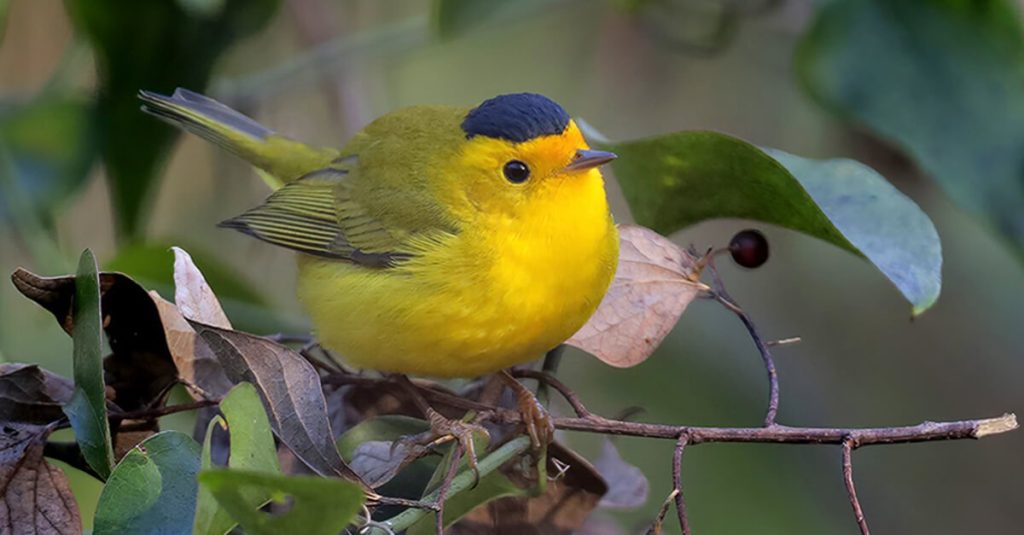
Wilson’s Warblers can be spotted in Ohio during the spring and fall migrations, appearing from April to May and again from August to September.
These warblers exhibit vibrant yellow plumage, with males possessing a distinctive black cap that extends to the throat. Females showcase a more subtle appearance with a grayish-green cap.
- Scientific Name: Cardellina pusilla
- Length: 4.3-4.7 inches (11-12 cm)
- Weight: 0.3-0.4 ounces (8-11 g)
- Wingspan: 6.7-7.5 inches (17-19 cm)
Wilson’s Warblers breed in the western United States and Canada. During migration, they can be observed across most of the United States.
These active warblers primarily forage for insects, often flicking their wings and tail while searching for prey.
Listen to the cheerful song of the Wilson’s Warbler:
Credit: Jonathon Jongsma, XC606040. Accessible at www.xeno-canto.org/606040.
Nests of Wilson’s Warblers are typically constructed on the ground, often hidden among dense vegetation. They are made from grass, leaves, and moss, forming a well-concealed cup-shaped structure. These warblers lay a clutch of approximately four to six eggs, which hatch after an incubation period of about twelve days. The young ones remain in the nest for another nine to ten days before fledging.
To attract Wilson’s Warblers to your backyard during migration, provide suitable habitat with dense shrubs and a variety of insects.
Fun Fact: Wilson’s Warblers are known for their constant tail-wagging behavior, which adds to their lively and energetic appearance.
20. Northern Waterthrush
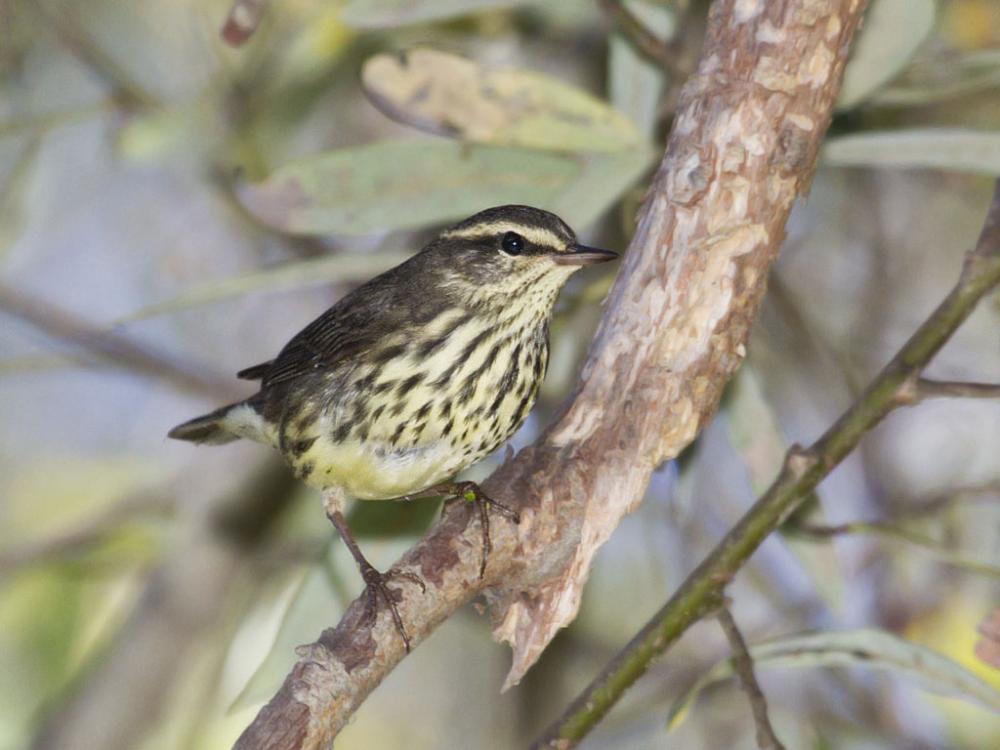
Northern Waterthrushes can be found in Ohio during the spring and fall migrations, appearing from April to May and again from August to September.
These warblers have a more thrush-like appearance compared to other warbler species. They showcase streaked brown upperparts, a white belly, and bold streaking on their flanks.
- Scientific Name: Parkesia noveboracensis
- Length: 5.1-5.5 inches (13-14 cm)
- Weight: 0.4-0.6 ounces (11-17 g)
- Wingspan: 7.5-8.3 inches (19-21 cm)
Northern Waterthrushes breed in the boreal forests of Canada and Alaska, as well as parts of the northeastern United States. During migration, they can be observed across most of the eastern and central United States.
These warblers prefer habitats near water, such as marshes, swamps, and streams, where they actively feed on insects and aquatic invertebrates.
Listen to the distinctive song of the Northern Waterthrush:
Credit: Andrew Spencer, XC431006. Accessible at www.xeno-canto.org/431006.
Nests of Northern Waterthrushes are typically constructed on the ground, often concealed among vegetation or tree roots near water. They are made from grass, leaves, and other plant materials, forming an open cup-shaped structure. These warblers lay a clutch of approximately four to six eggs, which hatch after an incubation period of about twelve to fourteen days. The young ones remain in the nest for another nine to ten days before fledging.
To attract Northern Waterthrushes to your backyard during migration, provide suitable habitat with water sources, dense vegetation, and a variety of insects.
Fun Fact: Northern Waterthrushes have a habit of bobbing their bodies and tails, similar to a teetering motion, as they walk along the ground or near the water’s edge.
21. Pine Warbler
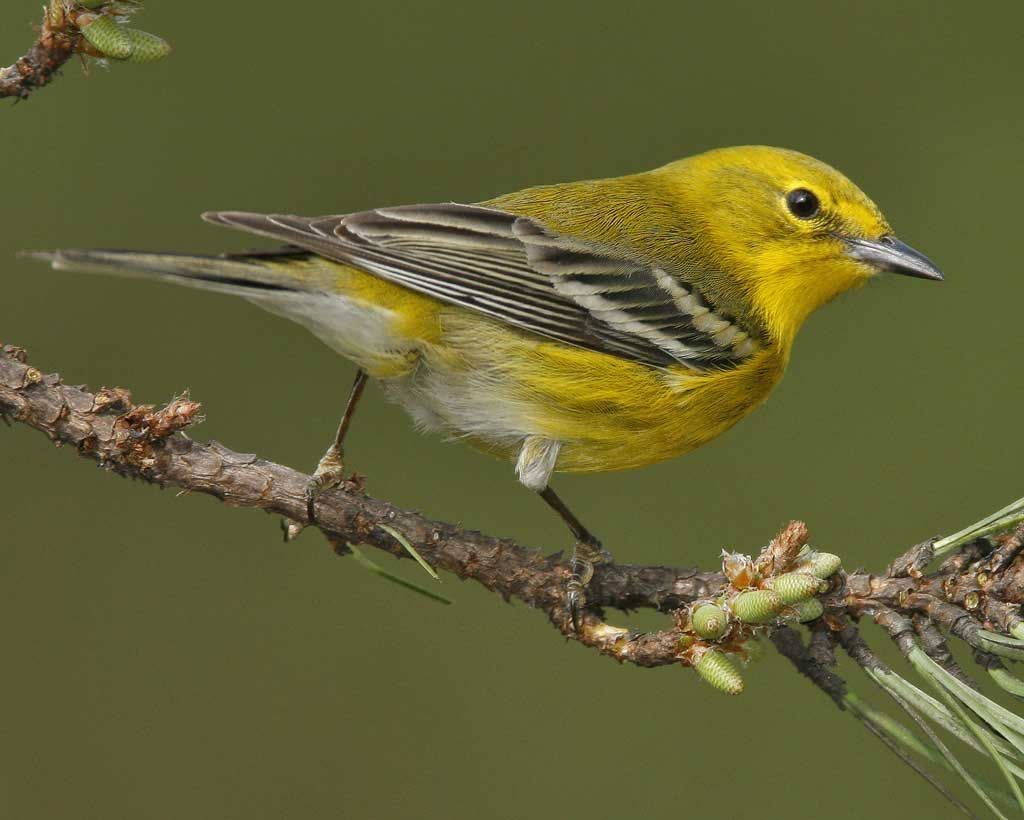
Pine Warblers can be observed in Ohio during the spring and fall migrations, appearing from April to May and again from September to October.
These warblers showcase a predominantly yellow plumage, with males having brighter yellow tones compared to females. They have grayish-olive wings and backs, and their undertail coverts are usually white.
- Scientific Name: Setophaga pinus
- Length: 4.7-5.9 inches (12-15 cm)
- Weight: 0.3-0.4 ounces (8-11 g)
- Wingspan: 8.7-9.8 inches (22-25 cm)
Pine Warblers breed in the eastern United States, including Ohio, and parts of Canada. During migration, they can be observed in various regions of the United States.
These warblers prefer coniferous forests and pine stands, where they forage for insects, including caterpillars, beetles, and spiders.
Listen to the pleasant song of the Pine Warbler:
Credit: Richard E. Webster, XC388266. Accessible at www.xeno-canto.org/388266.
Nests of Pine Warblers are typically constructed in the upper branches of pine trees, often near the trunk. They are made from twigs, grasses, bark strips, and spider silk, forming a sturdy cup-shaped structure. These warblers lay a clutch of approximately three to five eggs, which hatch after an incubation period of about twelve to fourteen days. The young ones remain in the nest for another ten to twelve days before fledging.
To attract Pine Warblers to your backyard during migration, provide suitable habitat with pine trees and offer a variety of insects.
Fun Fact: Pine Warblers are known for their ability to extract seeds from pine cones by prying the scales open with their bill.
22. Canada Warbler
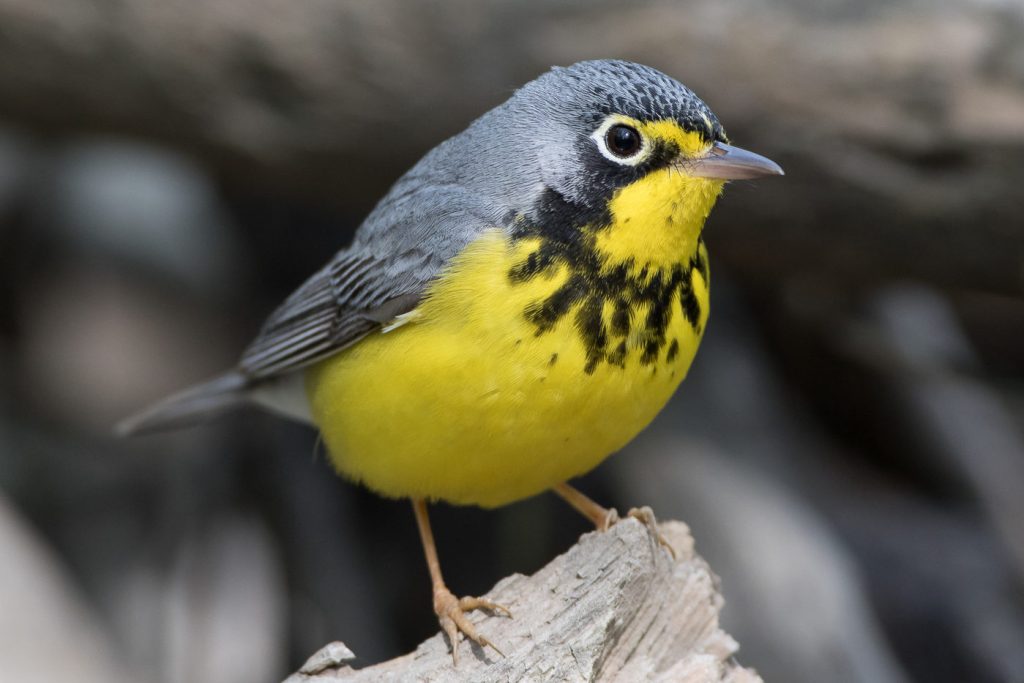
Canada Warblers can be found in Ohio during the spring and fall migrations, appearing from May to June and again from August to September.
These warblers possess a unique and striking appearance. They have grayish-blue upperparts, a yellow throat and breast, and a distinctive necklace-like pattern of black streaks on their chest.
- Scientific Name: Cardellina canadensis
- Length: 4.7-5.5 inches (12-14 cm)
- Weight: 0.3-0.4 ounces (8-11 g)
- Wingspan: 7.5-8.7 inches (19-22 cm)
Canada Warblers breed in the boreal forests of Canada and parts of the northeastern United States. During migration, they can be observed in various regions of the United States.
These warblers prefer moist and dense forests, often near water sources, where they actively forage for insects, including beetles, flies, and caterpillars.
Listen to the melodious song of the Canada Warbler:
Credit: Andrew Spencer, XC352774. Accessible at www.xeno-canto.org/352774.
Nests of Canada Warblers are typically constructed on the ground, often concealed among vegetation or tree roots. They are made from grass, leaves, and other plant materials, forming a well-hidden cup-shaped structure. These warblers lay a clutch of approximately four to five eggs, which hatch after an incubation period of about twelve to thirteen days. The young ones remain in the nest for another nine to ten days before fledging.
To attract Canada Warblers to your backyard during migration, provide suitable habitat with dense vegetation, a water source, and a variety of insects.
Fun Fact: Canada Warblers are known for their unique long-distance migration, with some individuals traveling over 12,000 miles round trip from their breeding grounds to their wintering grounds in South America
21. Pine Warbler

Pine Warblers can be observed in Ohio during the spring and fall migrations, appearing from April to May and again from September to October.
These warblers showcase a predominantly yellow plumage, with males having brighter yellow tones compared to females. They have grayish-olive wings and backs, and their undertail coverts are usually white.
- Scientific Name: Setophaga pinus
- Length: 4.7-5.9 inches (12-15 cm)
- Weight: 0.3-0.4 ounces (8-11 g)
- Wingspan: 8.7-9.8 inches (22-25 cm)
Pine Warblers breed in the eastern United States, including Ohio, and parts of Canada. During migration, they can be observed in various regions of the United States.
These warblers prefer coniferous forests and pine stands, where they forage for insects, including caterpillars, beetles, and spiders.
Listen to the pleasant song of the Pine Warbler:
Credit: Richard E. Webster, XC388266. Accessible at www.xeno-canto.org/388266.
Nests of Pine Warblers are typically constructed in the upper branches of pine trees, often near the trunk. They are made from twigs, grasses, bark strips, and spider silk, forming a sturdy cup-shaped structure. These warblers lay a clutch of approximately three to five eggs, which hatch after an incubation period of about twelve to fourteen days. The young ones remain in the nest for another ten to twelve days before fledging.
To attract Pine Warblers to your backyard during migration, provide suitable habitat with pine trees and offer a variety of insects.
Fun Fact: Pine Warblers are known for their ability to extract seeds from pine cones by prying the scales open with their bill.
22. Canada Warbler

Canada Warblers can be found in Ohio during the spring and fall migrations, appearing from May to June and again from August to September.
These warblers possess a unique and striking appearance. They have grayish-blue upperparts, a yellow throat and breast, and a distinctive necklace-like pattern of black streaks on their chest.
- Scientific Name: Cardellina canadensis
- Length: 4.7-5.5 inches (12-14 cm)
- Weight: 0.3-0.4 ounces (8-11 g)
- Wingspan: 7.5-8.7 inches (19-22 cm)
Canada Warblers breed in the boreal forests of Canada and parts of the northeastern United States. During migration, they can be observed in various regions of the United States.
These warblers prefer moist and dense forests, often near water sources, where they actively forage for insects, including beetles, flies, and caterpillars.
Listen to the melodious song of the Canada Warbler:
Credit: Andrew Spencer, XC352774. Accessible at www.xeno-canto.org/352774.
Nests of Canada Warblers are typically constructed on the ground, often concealed among vegetation or tree roots. They are made from grass, leaves, and other plant materials, forming a well-hidden cup-shaped structure. These warblers lay a clutch of approximately four to five eggs, which hatch after an incubation period of about twelve to thirteen days. The young ones remain in the nest for another nine to ten days before fledging.
To attract Canada Warblers to your backyard during migration, provide suitable habitat with dense vegetation, a water source, and a variety of insects.
Fun Fact: Canada Warblers are known for their unique long-distance migration, with some individuals traveling over 12,000 miles round trip from their breeding grounds to their wintering grounds in South America.
23. Mourning Warbler
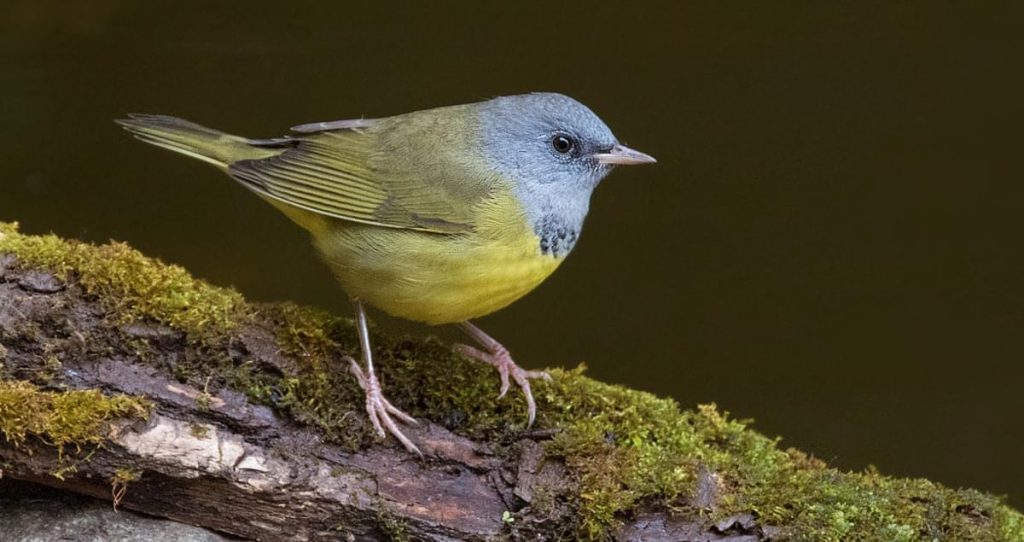
Mourning Warblers can be observed in Ohio during the spring and fall migrations, appearing from May to June and again from August to September.
These warblers have a unique and distinctive appearance. They possess a gray head, neck, and upperparts, with a yellow throat, breast, and belly. They also have a bold black patch on their chest.
- Scientific Name: Geothlypis philadelphia
- Length: 4.7-5.1 inches (12-13 cm)
- Weight: 0.3-0.4 ounces (9-11 g)
- Wingspan: 7.5-8.3 inches (19-21 cm)
Mourning Warblers breed in the boreal forests of Canada and parts of the northeastern United States. During migration, they can be observed in various regions of the United States.
These warblers prefer dense and shrubby habitats, often near wetlands or streams, where they actively search for insects, spiders, and small fruits.
Listen to the distinct song of the Mourning Warbler:
Credit: Paul Marvin, XC428396. Accessible at www.xeno-canto.org/428396.
Nests of Mourning Warblers are typically constructed on or near the ground, often concealed among vegetation. They are made from grass, leaves, and other plant materials, forming a well-hidden cup-shaped structure. These warblers lay a clutch of approximately four to five eggs, which hatch after an incubation period of about twelve days. The young ones remain in the nest for another eight to ten days before fledging.
To attract Mourning Warblers to your backyard during migration, provide suitable habitat with dense shrubs, a water source, and a variety of insects and small fruits.
Fun Fact: Mourning Warblers are known for their shy and elusive behavior, often staying hidden among dense vegetation, making them challenging to spot.
24. Orange-crowned Warbler
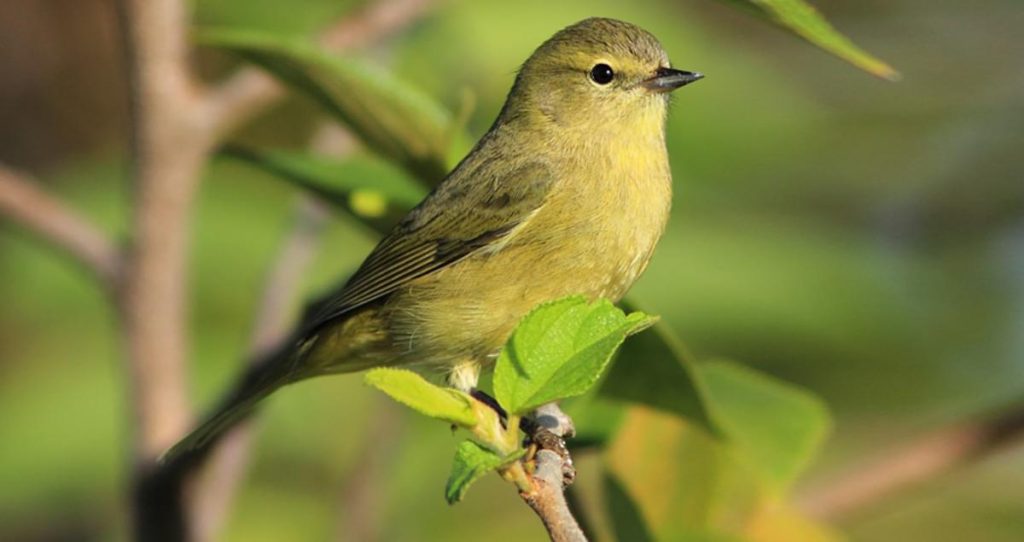
Orange-crowned Warblers can be spotted in Ohio during the spring and fall migrations, appearing from April to May and again from September to October.
These warblers have a relatively plain appearance compared to others. They showcase olive-green upperparts, a yellowish belly, and, as the name suggests, a hidden orange crown that is often difficult to see.
- Scientific Name: Oreothlypis celata
- Length: 4.7-5.1 inches (12-13 cm)
- Weight: 0.3-0.4 ounces (9-11 g)
- Wingspan: 7.5-8.3 inches (19-21 cm)
Orange-crowned Warblers breed in various regions of North America, including parts of Canada, Alaska, and the western United States. During migration, they can be observed in different areas of the United States.
These warblers inhabit a wide range of habitats, including forests, woodlands, shrubby areas, and even gardens. They primarily feed on insects, spiders, and small fruits.
Listen to the subtle song of the Orange-crowned Warbler:
Credit: Greg Irving, XC645609. Accessible at www.xeno-canto.org/645609.
Nests of Orange-crowned Warblers are typically constructed on or near the ground, often hidden among vegetation or in low shrubs. They are made from grass, leaves, and other plant materials, forming a well-camouflaged cup-shaped structure. These warblers lay a clutch of approximately four to six eggs, which hatch after an incubation period of about twelve to thirteen days. The young ones remain in the nest for another eight to ten days before fledging.
To attract Orange-crowned Warblers to your backyard during migration, provide suitable habitat with diverse vegetation, including shrubs and trees, as well as a water source and a variety of insects and small fruits.
Fun Fact: The orange crown of the Orange-crowned Warbler is not always visible, as they often keep it hidden and only reveal it during certain behaviors or when agitated.
25. Golden-winged Warbler
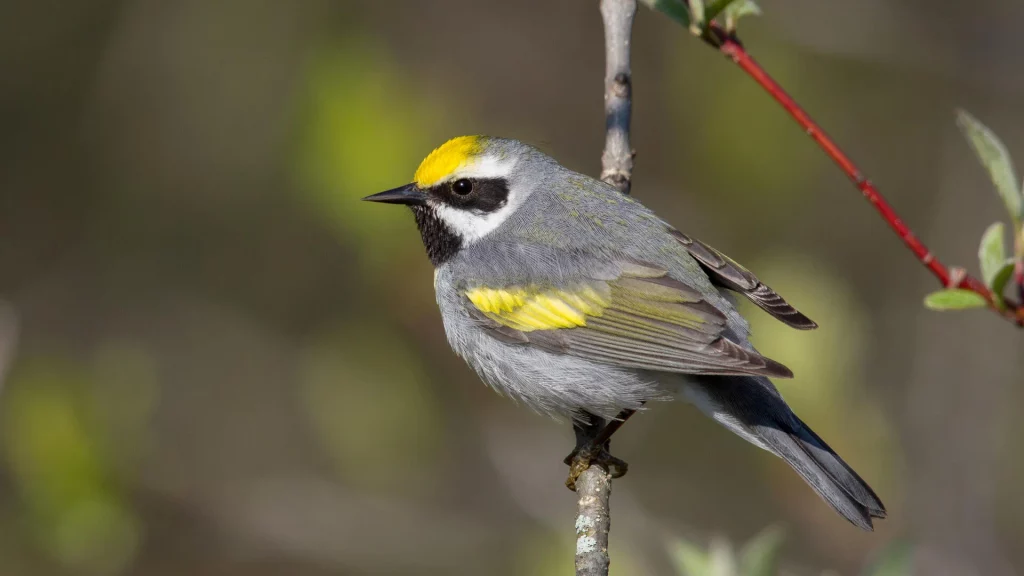
Golden-winged Warblers can be found in Ohio during the spring and fall migrations, appearing from April to May and again from August to September.
These warblers exhibit a striking and unique appearance. They have blue-gray upperparts, bright yellow plumage on their head, breast, and belly, and distinctive golden-yellow wing bars.
- Scientific Name: Vermivora chrysoptera
- Length: 4.7-5.1 inches (12-13 cm)
- Weight: 0.3-0.4 ounces (9-11 g)
- Wingspan: 7.5-8.3 inches (19-21 cm)
Golden-winged Warblers breed in various regions of North America, including parts of Canada and the northeastern United States. During migration, they can be observed in different areas of the United States.
These warblers inhabit a range of habitats, including shrubby areas, young forests, and regenerating clearings. They primarily feed on insects, including caterpillars, beetles, and flies.
Listen to the pleasant song of the Golden-winged Warbler:
Credit: Wil Hershberger, XC547662. Accessible at www.xeno-canto.org/547662.
Nests of Golden-winged Warblers are typically constructed on the ground or low in shrubs, often hidden among vegetation. They are made from grass, leaves, and other plant materials, forming a well-concealed cup-shaped structure. These warblers lay a clutch of approximately three to five eggs, which hatch after an incubation period of about twelve to thirteen days. The young ones remain in the nest for another nine to ten days before fledging.
To attract Golden-winged Warblers to your backyard during migration, provide suitable habitat with dense shrubs, young trees, and a variety of insects.
Fun Fact: Golden-winged Warblers hybridize with Blue-winged Warblers, resulting in a unique hybrid known as the “Brewster’s Warbler,” which exhibits a combination of characteristics from both species.
26. Connecticut Warbler
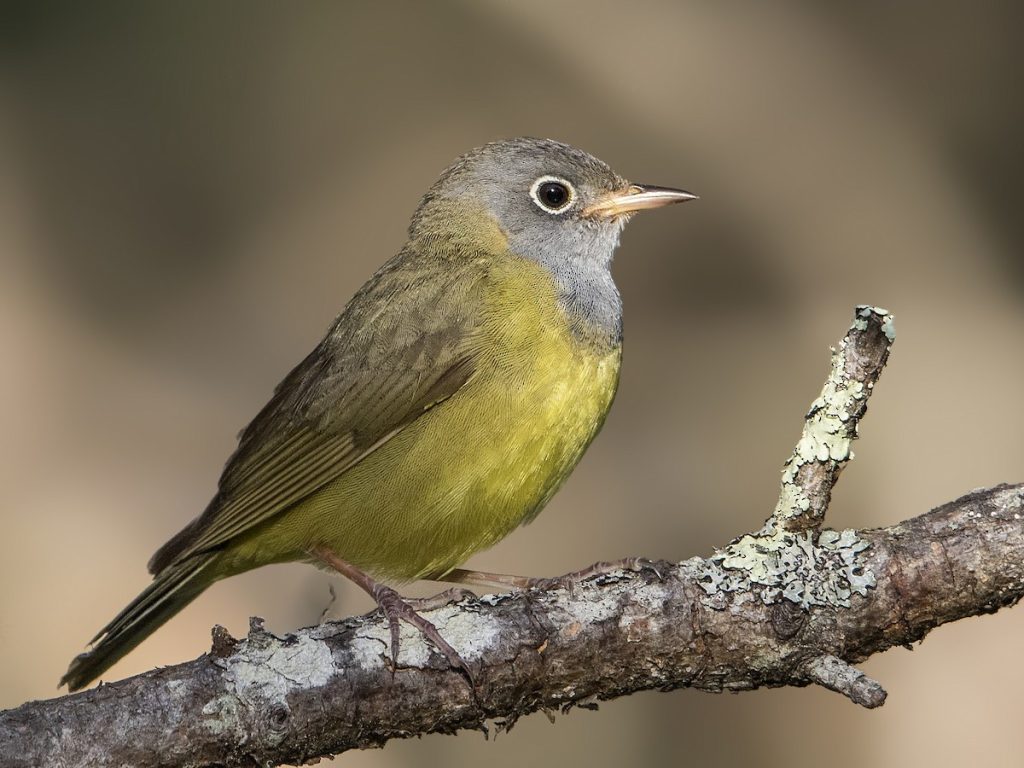
Connecticut Warblers can be spotted in Ohio during the spring and fall migrations, appearing from May to June and again from August to September.
These warblers have a unique appearance with olive-brown upperparts, a grayish throat, and a bright yellow belly. They also have a distinctive pale eye ring.
- Scientific Name: Oporornis agilis
- Length: 5.5-6.3 inches (14-16 cm)
- Weight: 0.5-0.6 ounces (14-17 g)
- Wingspan: 8.7-9.8 inches (22-25 cm)
Connecticut Warblers breed in the boreal forests of Canada and parts of the northern United States. During migration, they can be observed in various regions of the United States.
These warblers prefer dense, shrubby habitats, often near wetlands or along stream edges. They primarily feed on insects, including beetles, flies, and caterpillars.
Listen to the unique song of the Connecticut Warbler:
Credit: Frank Lambert, XC530109. Accessible at www.xeno-canto.org/530109.
Nests of Connecticut Warblers are typically constructed on or near the ground, often hidden among vegetation or in mossy areas. They are made from grass, leaves, and other plant materials, forming a well-camouflaged cup-shaped structure. These warblers lay a clutch of approximately four to six eggs, which hatch after an incubation period of about twelve to thirteen days. The young ones remain in the nest for another nine to ten days before fledging.
To attract Connecticut Warblers to your backyard during migration, provide suitable habitat with dense shrubs, wetland areas, and a variety of insects.
Fun Fact: Connecticut Warblers were named after the state of Connecticut, where one of the first specimens was collected, but they are not commonly found in the state during the breeding season.
27. Black-throated Blue Warbler

Black-throated Blue Warblers can be found in Ohio during the spring and fall migrations, appearing from April to May and again from August to September.
These warblers display a distinctive and eye-catching appearance. Males have deep blue upperparts and a bold black throat and face, while females have a more subdued plumage with olive-brown upperparts and a lighter yellowish throat.
- Scientific Name: Setophaga caerulescens
- Length: 4.7-5.5 inches (12-14 cm)
- Weight: 0.3-0.4 ounces (9-11 g)
- Wingspan: 7.5-8.3 inches (19-21 cm)
Black-throated Blue Warblers breed in the northeastern United States and parts of southeastern Canada. During migration, they can be observed in various regions of the United States.
These warblers inhabit a range of habitats, including deciduous and mixed forests. They primarily feed on insects, spiders, and small fruits.
Listen to the song of the Black-throated Blue Warbler:
Credit: Andrew Spencer, XC366034. Accessible at www.xeno-canto.org/366034.
Nests of Black-throated Blue Warblers are typically constructed on or near the ground, hidden among leaf litter or low vegetation. They are made from twigs, leaves, and other plant materials, forming a well-hidden cup-shaped structure. These warblers lay a clutch of approximately three to four eggs, which hatch after an incubation period of about twelve to thirteen days. The young ones remain in the nest for another eight to nine days before fledging.
To attract Black-throated Blue Warblers to your backyard during migration, provide suitable habitat with mature trees, understory vegetation, and a variety of insects and small fruits.
Fun Fact: Male Black-throated Blue Warblers play a significant role in parental care, assisting with feeding and caring for the young ones, which is uncommon among warbler species.
28. Black-throated Gray Warbler
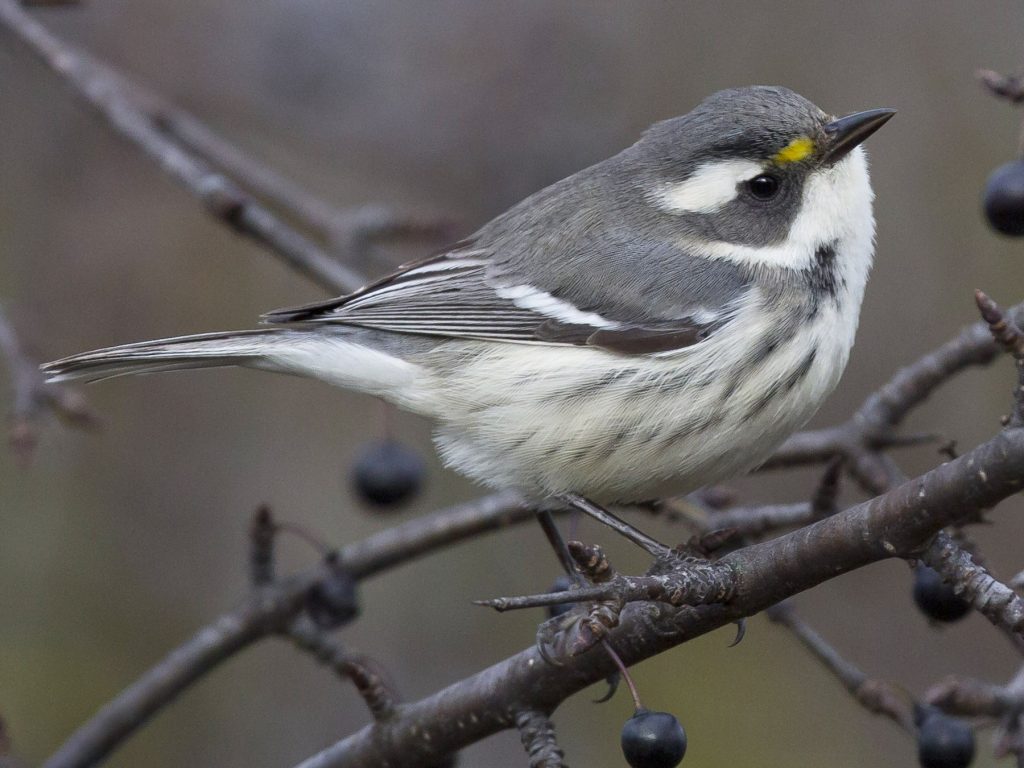
Black-throated Gray Warblers can be observed in Ohio during the spring and fall migrations, appearing from April to May and again from August to September.
These warblers have a distinct and striking appearance. They showcase gray upperparts, a white face with a black throat, and white undersides with black streaks. Females have a slightly duller plumage.
- Scientific Name: Setophaga nigrescens
- Length: 4.7-5.1 inches (12-13 cm)
- Weight: 0.3-0.4 ounces (9-11 g)
- Wingspan: 7.5-8.3 inches (19-21 cm)
Black-throated Gray Warblers breed in the western United States and parts of southwestern Canada. During migration, they can be observed in various regions of the United States.
These warblers prefer open woodlands, often with oak or pine trees, and they forage actively for insects, spiders, and small berries.
Listen to the song of the Black-throated Gray Warbler:
Credit: Doug Herrington, XC479113. Accessible at www.xeno-canto.org/479113.
Nests of Black-throated Gray Warblers are typically constructed in low vegetation or shrubs, often close to the ground. They are made from grass, bark, and other plant materials, forming a well-hidden cup-shaped structure. These warblers lay a clutch of approximately three to five eggs, which hatch after an incubation period of about twelve to fourteen days. The young ones remain in the nest for another eight to ten days before fledging.
To attract Black-throated Gray Warblers to your backyard during migration, provide suitable habitat with open woodlands, shrubby areas, and a variety of insects and small berries.
Fun Fact: Black-throated Gray Warblers have a distinctive behavior called “tail-pumping,” where they rapidly raise and lower their tails while foraging or when agitated.
29. Yellow-throated Warbler
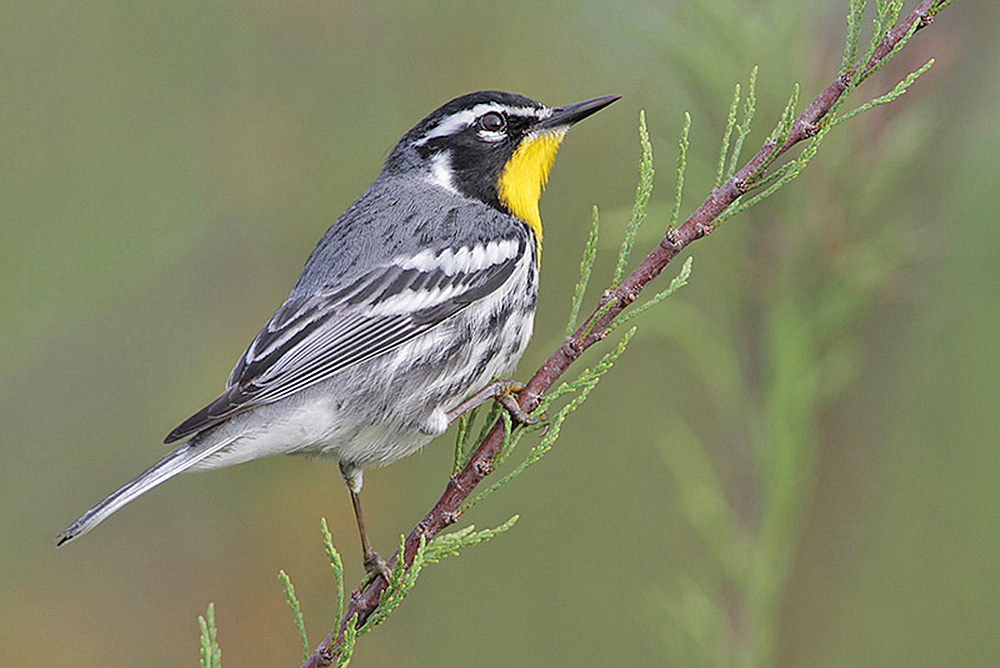
Yellow-throated Warblers can be spotted in Ohio during the spring and fall migrations, appearing from April to May and again from August to September.
These warblers have a striking appearance with a yellow throat and upper breast, contrasting with their grayish upperparts. They also have a black band across their eyes, giving them a distinctive look.
- Scientific Name: Setophaga dominica
- Length: 5.5-5.9 inches (14-15 cm)
- Weight: 0.4-0.5 ounces (11-14 g)
- Wingspan: 9.4-9.8 inches (24-25 cm)
Yellow-throated Warblers breed in the southeastern United States, primarily in swampy areas with mature trees. During migration, they can be observed in various regions of the United States.
These warblers inhabit forested wetlands, bottomlands, and river corridors. They primarily feed on insects, including caterpillars, beetles, and spiders.
Listen to the distinctive song of the Yellow-throated Warbler:
Credit: Lance A. M. Benner, XC567020. Accessible at www.xeno-canto.org/567020.
Nests of Yellow-throated Warblers are typically constructed in the forks of trees, high above the ground. They are made from grass, bark strips, and other plant materials, forming a well-built cup-shaped structure. These warblers lay a clutch of approximately three to five eggs, which hatch after an incubation period of about twelve to fourteen days. The young ones remain in the nest for another ten to twelve days before fledging.
To attract Yellow-throated Warblers to your backyard during migration, provide suitable habitat with mature trees near wetlands or bodies of water, and ensure a sufficient supply of insects for their foraging needs.
Fun Fact: Yellow-throated Warblers are known for their unique feeding behavior called “gleaning,” where they actively search for insects on the undersides of leaves and tree bark.
30. Prothonotary Warbler
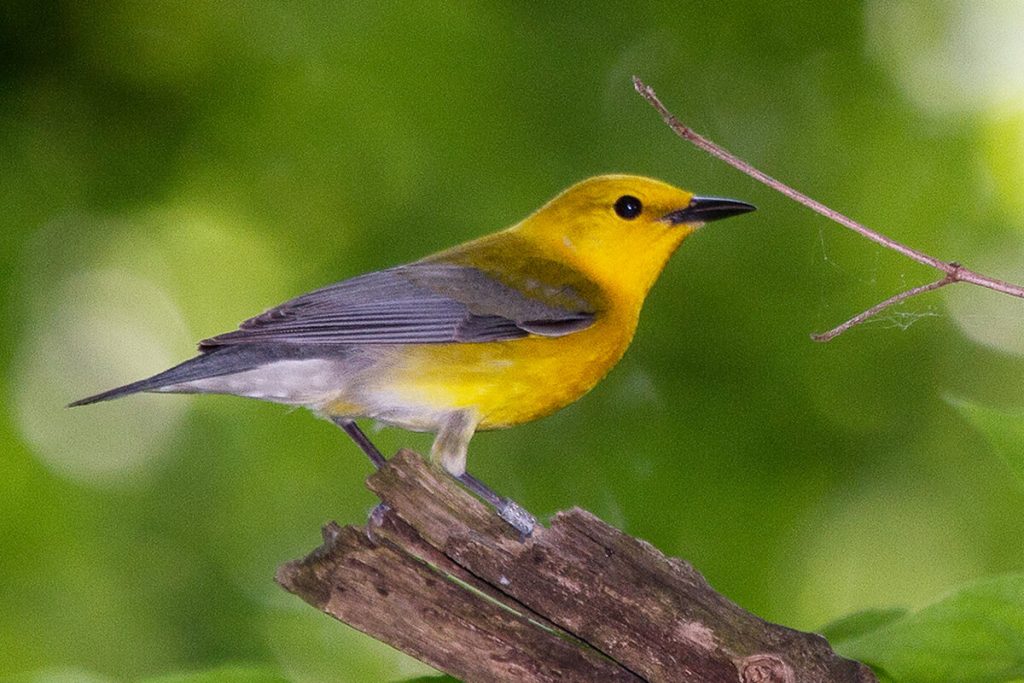
Prothonotary Warblers can be found in Ohio during the spring and fall migrations, appearing from April to May and again from August to September.
These warblers are strikingly beautiful, with bright yellow plumage and a distinctive blue-gray head. They stand out among other warbler species with their vibrant colors.
Scientific Name: Protonotaria citrea
Length: 4.3-5.1 inches (11-13 cm)
Weight: 0.3-0.4 ounces (9-11 g)
Wingspan: 7.5-8.3 inches (19-21 cm)
Prothonotary Warblers breed in the eastern United States and parts of Canada, primarily in swampy areas with standing water. During migration, they can be observed in various regions of the United States.
These warblers inhabit bottomland hardwood forests, swamps, and wetlands, often near water bodies. They primarily feed on insects, including beetles, flies, and caterpillars.
Listen to the melodious song of the Prothonotary Warbler:
Credit: Lance A. M. Benner, XC512298. Accessible at www.xeno-canto.org/512298.
Nests of Prothonotary Warblers are typically constructed in tree cavities or nest boxes near water. They are made from plant materials, such as grass, bark strips, and moss, forming a well-insulated cup-shaped structure. These warblers lay a clutch of approximately four to seven eggs, which hatch after an incubation period of about twelve to fifteen days. The young ones remain in the nest for another twelve to fifteen days before fledging.
To attract Prothonotary Warblers to your backyard during migration, provide suitable habitat with standing water, nest boxes, and a variety of insects.
Fun Fact: Prothonotary Warblers are the only eastern warbler species that nest in tree cavities, similar to cavity-nesting birds like woodpeckers and chickadees.
Guide to Warbler Melodies
The sweet tunes of warblers often precede their graceful appearances, and acquainting yourself with a handful of their melodies will aid in identifying the birds. Fortunately, some warblers boast more distinct songs than others.
Warbler melodies can be described as buzzing, crystalline, or trilling, with varying pitches and an intricate medley of sounds. A buzzing note resembles the hum of an insect, while a crystalline note resonates like a gentle whistle. The trill, on the other hand, is a rapid succession of notes impossible to discern individually.
In this comprehensive guide, you can audibly experience the songs of all the warblers. Take advantage of this resource that outlines 13 easily recognizable warbler melodies.
Warblers with Buzzing Melodies:
- The song of the Black-throated Blue Warbler ascends with a buzzing quality.
- Prairie Warblers also emit buzzing, ascending melodies.
- Black-throated Green Warblers produce a buzzing song with a few clear notes in the middle.
- Blackpoll Warblers’ song is clear and steady, resembling the buzz of an insect.
- Prairie Warblers’ song buzzes and ascends in pitch.
- The song of Palm Warblers is distinctly buzzy.
Warblers with Clear Note Melodies:
- Common Yellowthroats perform a series of rising and falling notes that are repeated.
- Ovenbirds sing a sequence of notes that ascend and descend.
- Hooded Warblers also produce clear notes.
- Chestnut-sided Warblers sing a series of falling, clear notes that accelerate toward the end.
- Yellow-rumped Warblers create a series of clear notes that gradually fade away.
- The song of Yellow Warblers accelerates.
- Northern Parulas deliver a rising trill that concludes with a distinct note, resembling a punctuation mark.
- Wilson’s Warblers sing a series of falling, clear notes that speed up.
Frequency of Warbler Sightings in Ohio during Summer and Winter
Checklists prove invaluable when determining which bird species are commonly observed in your state. These lists provide insights into the warblers most frequently documented on eBird checklists during Ohio’s summer and winter seasons.
Summer Warblers in Ohio:
- Yellow Warbler – 38.6%
- Common Yellowthroat – 31.1%
- Yellow-rumped Warbler – 15.7%
- American Redstart – 15.2%
- Palm Warbler – 11.1%
- Northern Parula – 10.7%
- Magnolia Warbler – 10.7%
- Black-throated Green Warbler – 10.5%
- Black-and-white Warbler – 9.7%
- Chestnut-sided Warbler – 9.6%
- Nashville Warbler – 9.1%
- Ovenbird – 7.9%
- Blackburnian Warbler – 7.8%
- Black-throated Blue Warbler – 7.6%
- Tennessee Warbler – 7.3%
- Prothonotary Warbler – 7.2%
- Bay-breasted Warbler – 6.4%
- Hooded Warbler – 6.1%
- Blackpoll Warbler – 5.6%
- Cape May Warbler – 5.4%
- Blue-winged Warbler – 4.6%
- Yellow-throated Warbler – 4.5%
- Wilson’s Warbler – 4.0%
- Northern Waterthrush – 4.0%
- Canada Warbler – 3.7%
- Yellow-breasted Chat – 3.5%
- Cerulean Warbler – 2.5%
- Louisiana Waterthrush – 2.0%
- Mourning Warbler – 1.8%
- Prairie Warbler – 1.7%
- Pine Warbler – 1.6%
- Kentucky Warbler – 1.6%
- Orange-crowned Warbler – 0.9%
- Golden-winged Warbler – 0.7%
- Worm-eating Warbler – 0.7%
- Connecticut Warbler – 0.3%
Winter Warblers in Ohio:
- Yellow-rumped Warbler – 2.7%
- Pine Warbler – 0.1%
- Orange-crowned Warbler – 0.1%
- Common Yellowthroat – <0.1%
- Ovenbird – <0.1%
- Palm Warbler – <0.1%
- Black-throated Blue Warbler – <0.1%
- Black-and-white Warbler – <0.1%
- Nashville Warbler – <0.1%
- Wilson’s Warbler – <0.1%
- Yellow-throated Warbler – <0.1%
- Yellow Warbler – <0.1%
- American Redstart – <0.1%
- Tennessee Warbler – <0.1%
- Magnolia Warbler – <0.1%
- Black-throated Green Warbler – <0.1%
- Chestnut-sided Warbler – <0.1%
- Cape May Warbler – <0.1%
- Louisiana Waterthrush – <0.1%
Attracting Warblers to Your Backyard
Although warblers are less frequent visitors to backyard feeders compared to other songbirds, there are methods to entice these melodious avian creatures to your premises:
- If your yard is spacious enough, provide ample trees.
- Maintain brush piles and resist the urge to excessively tidy your yard to create a habitat for insect friends.
- Avoid using pesticides or herbicides to ensure a thriving insect population for the birds without risking their consumption.
- Offer a clean water source.
- Present mealworms, preferably live ones, or dried ones as an alternative.
- Supply bird feeders with sunflower seeds, peanut hearts, and suet.
